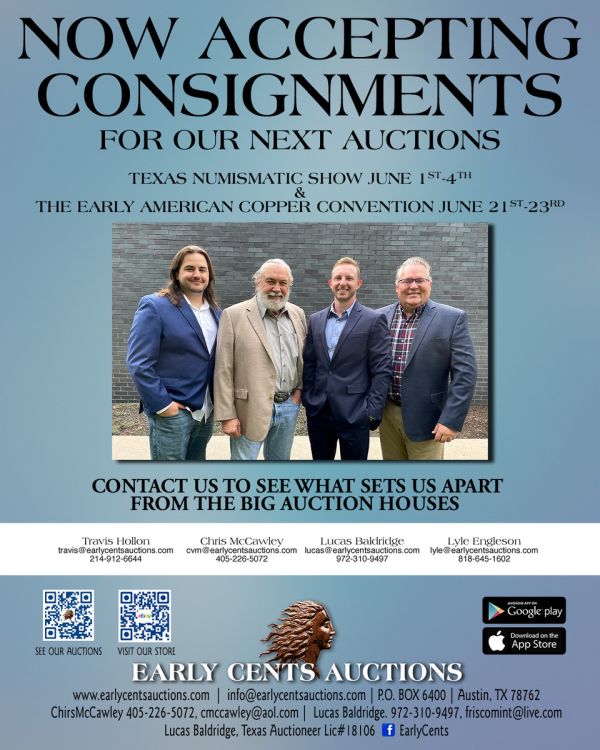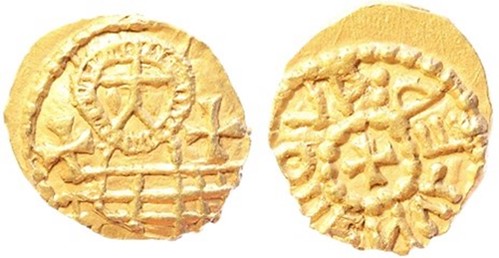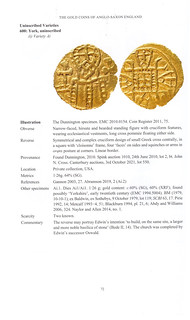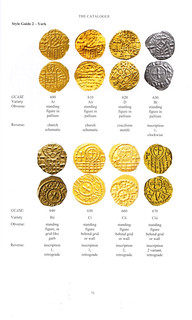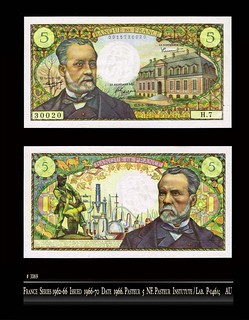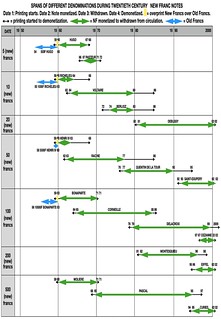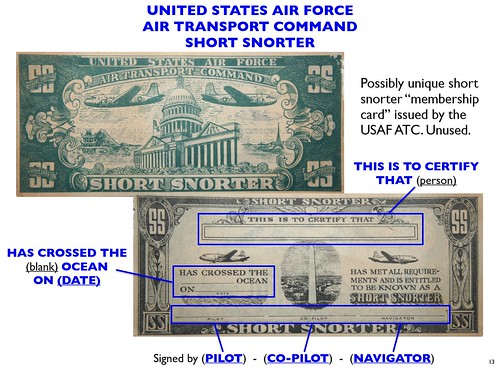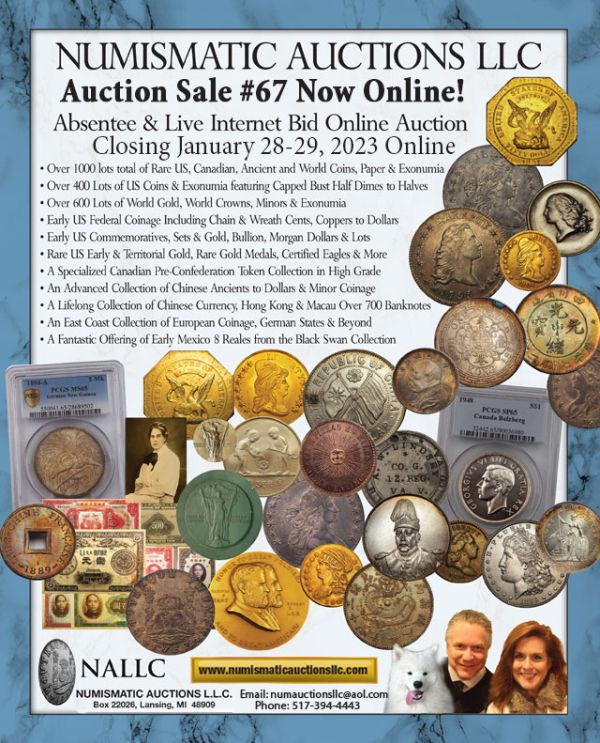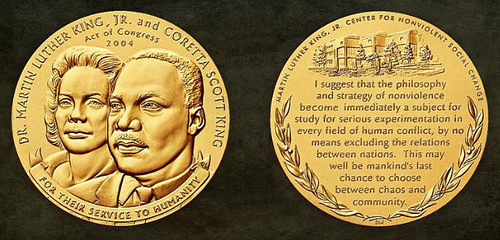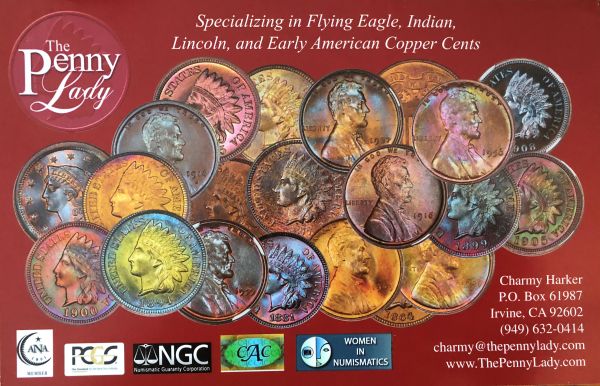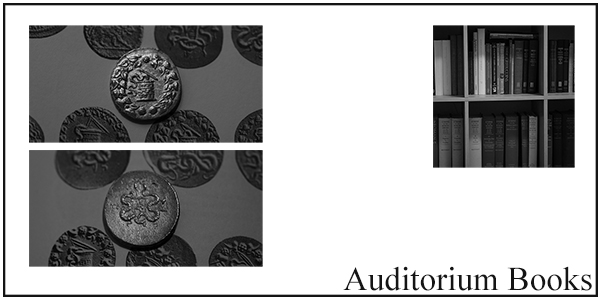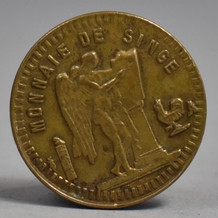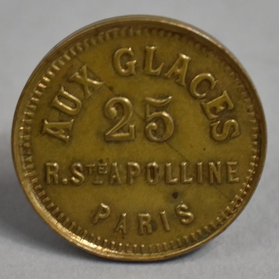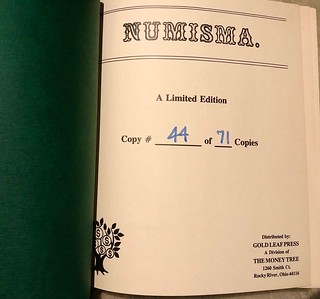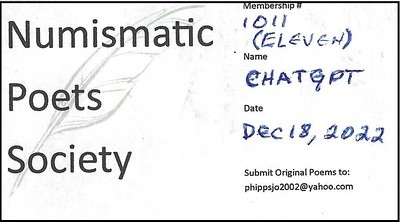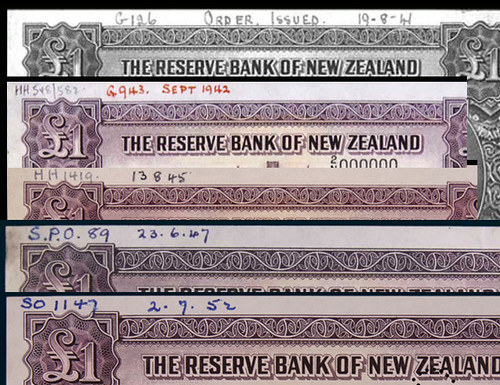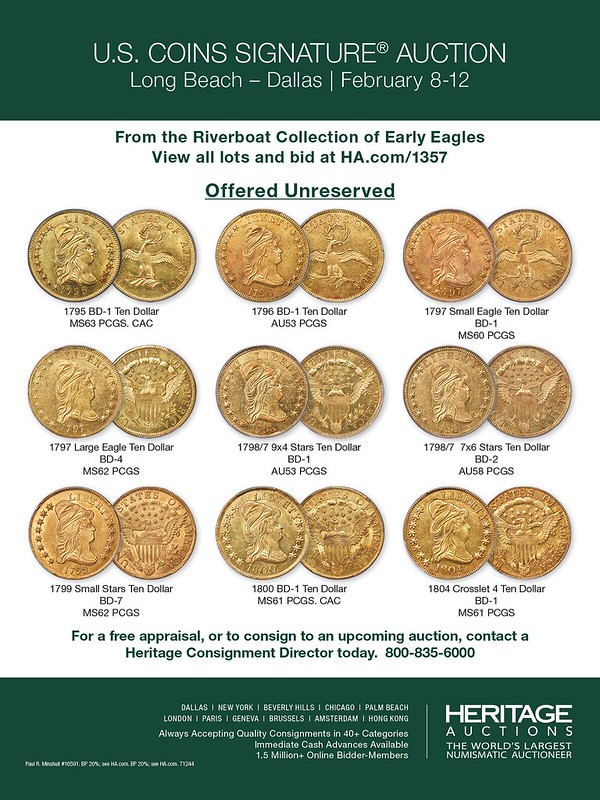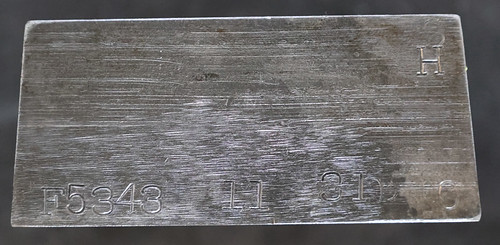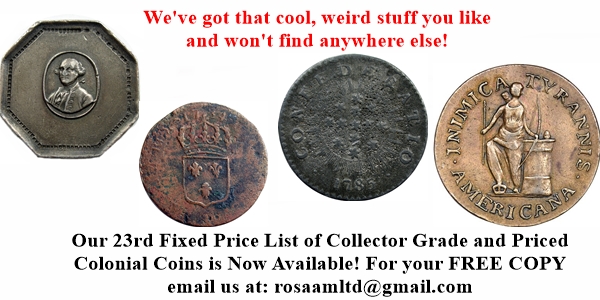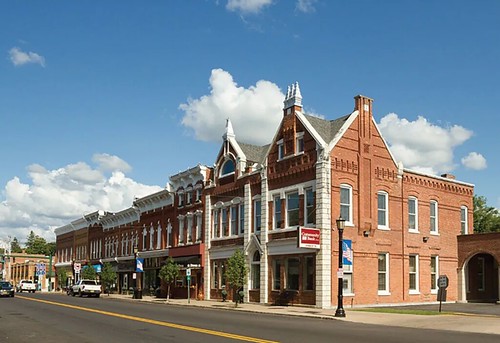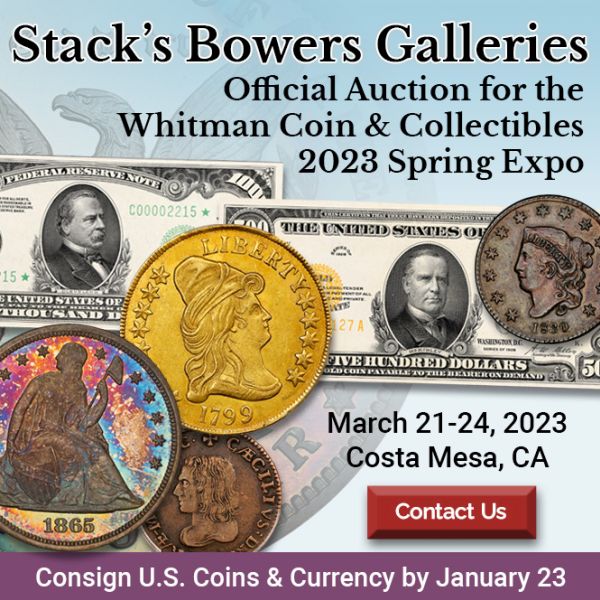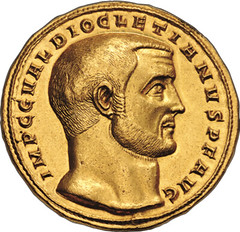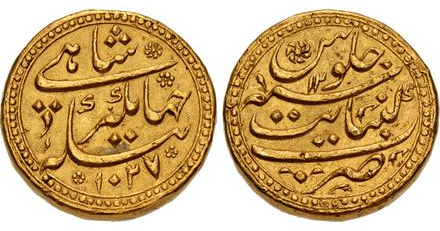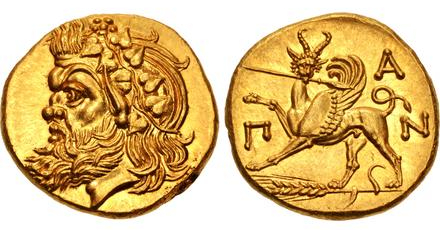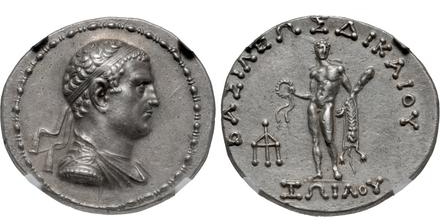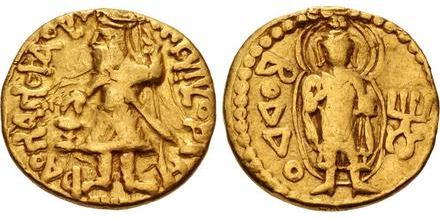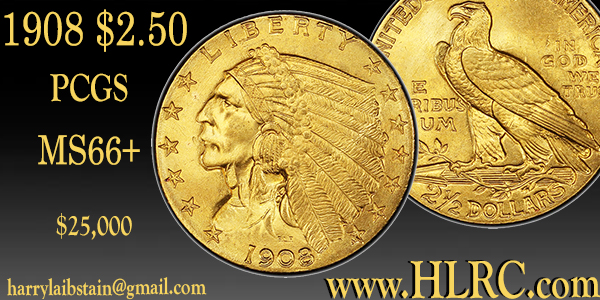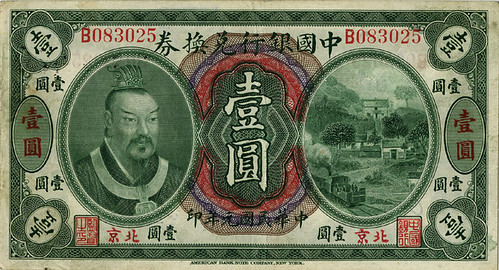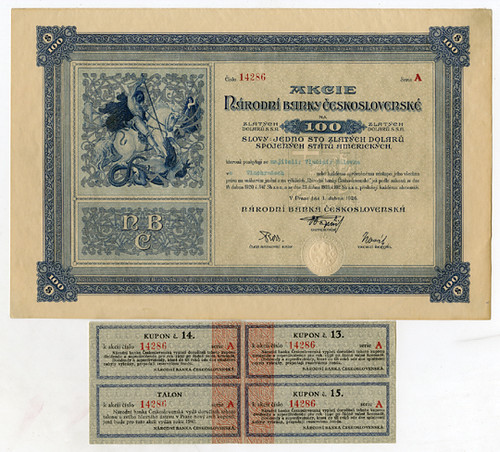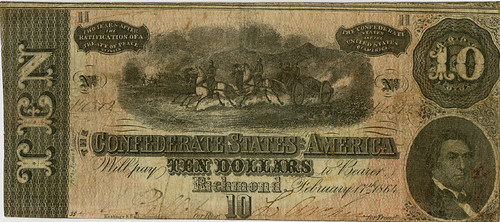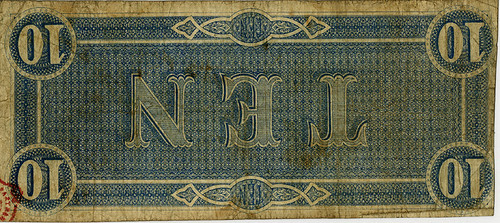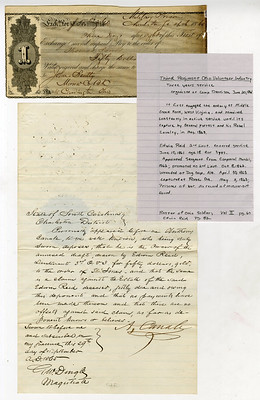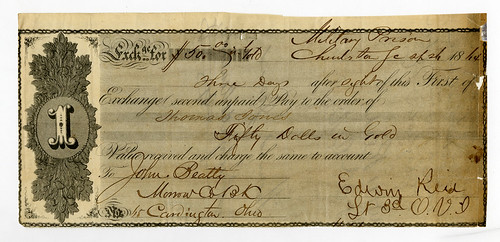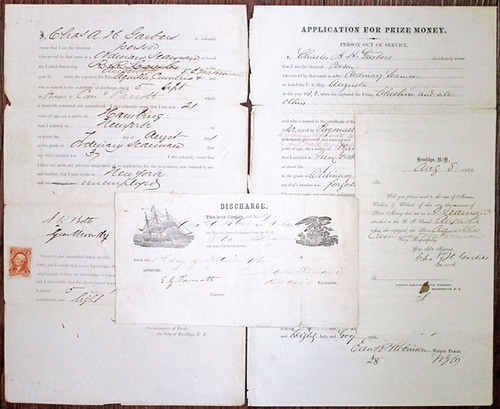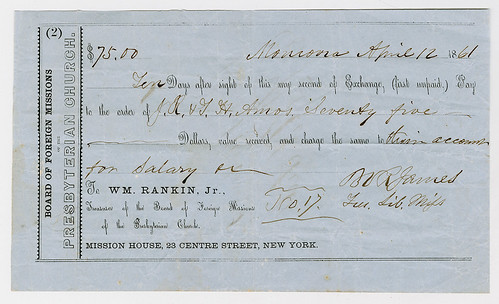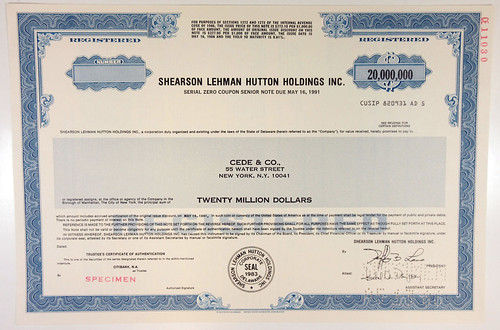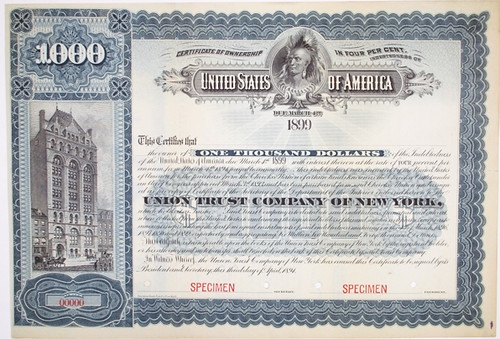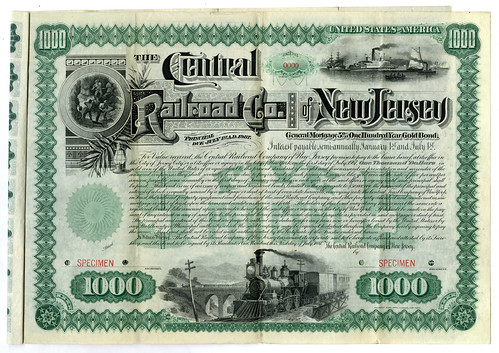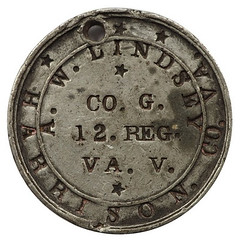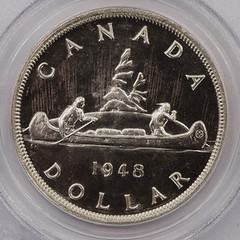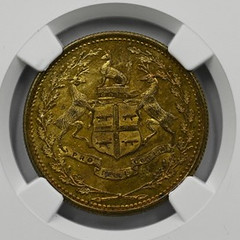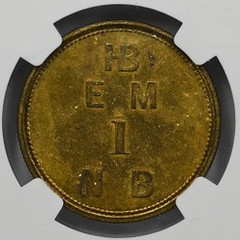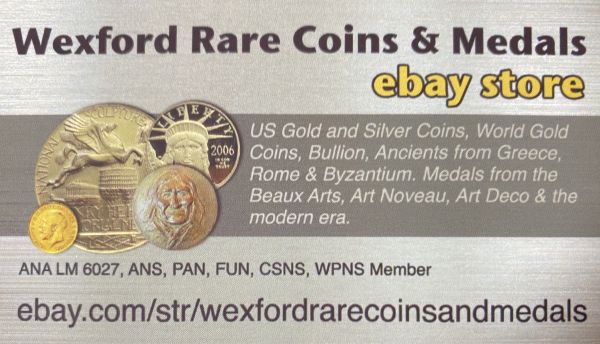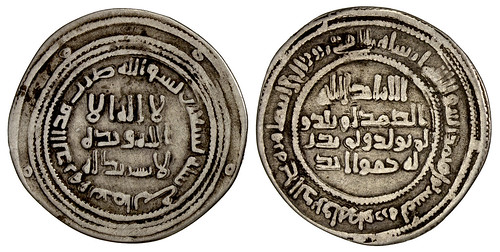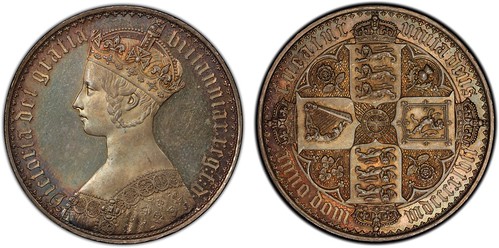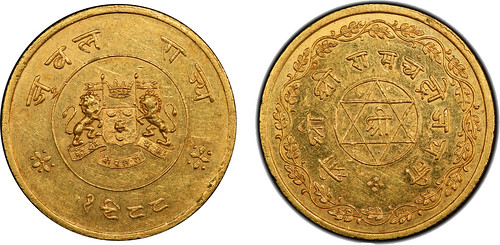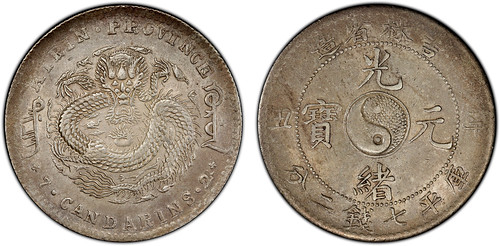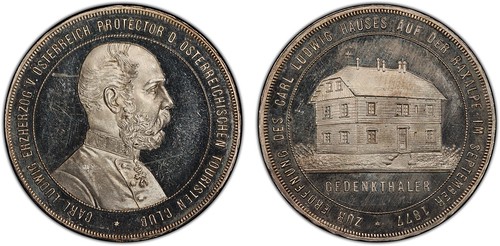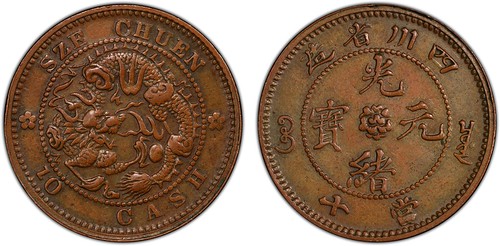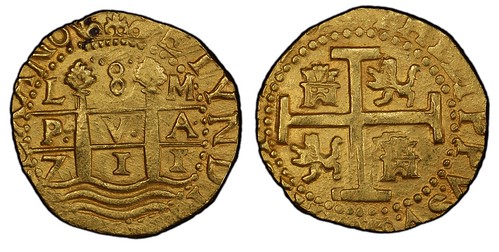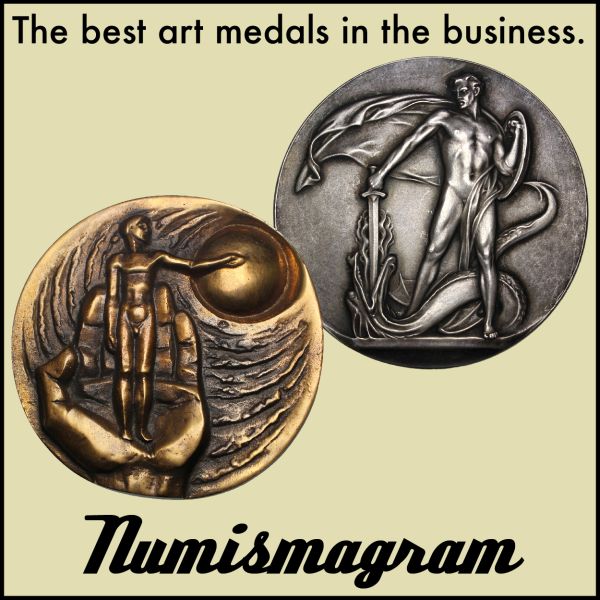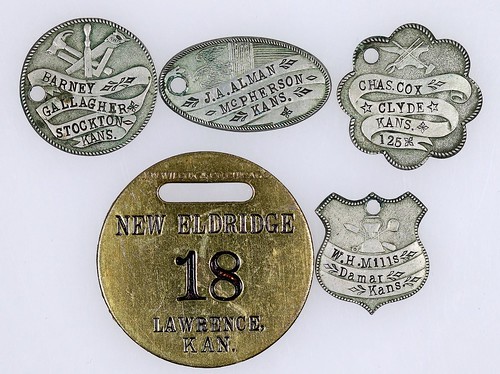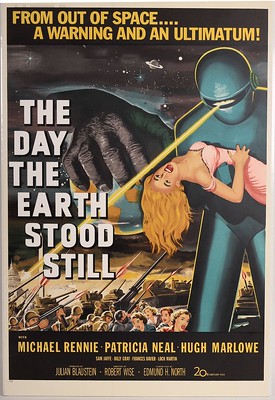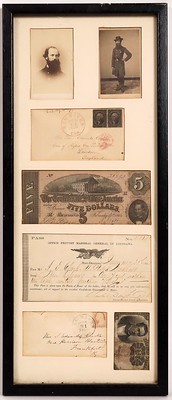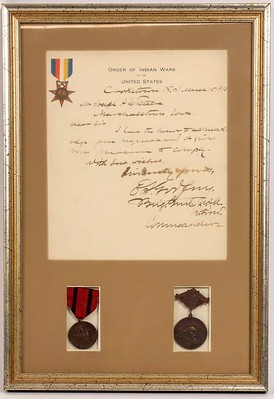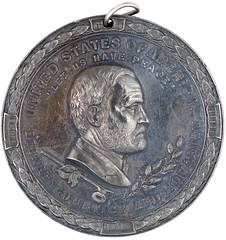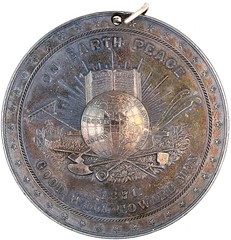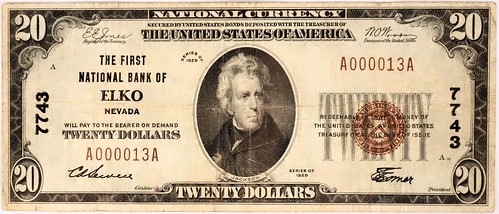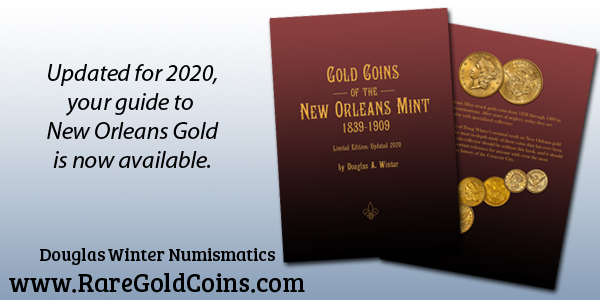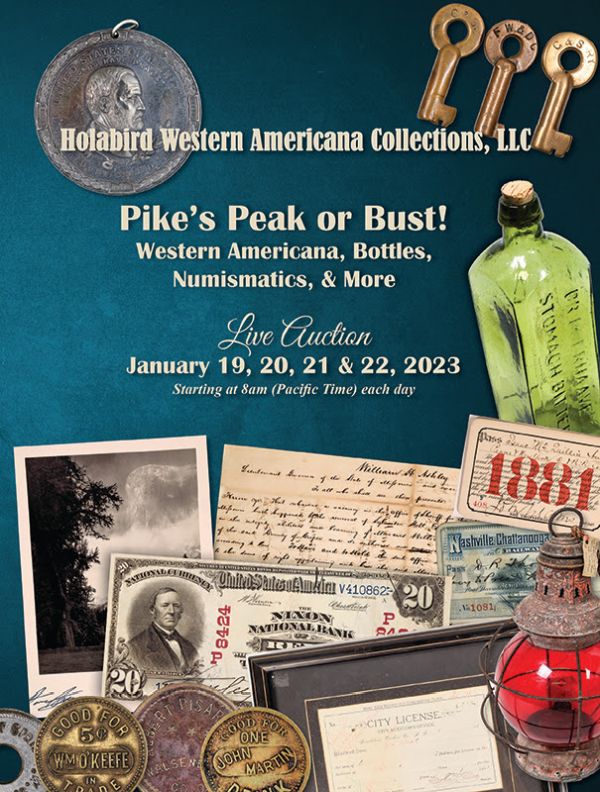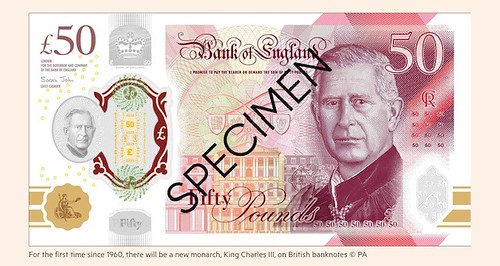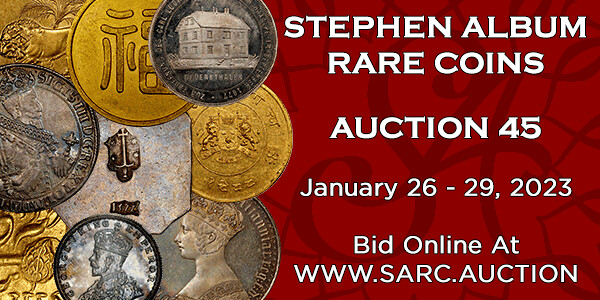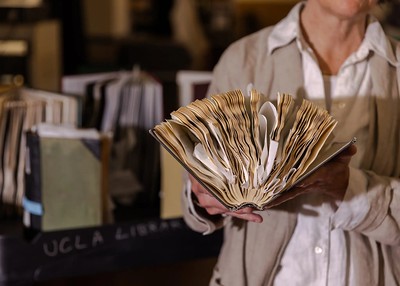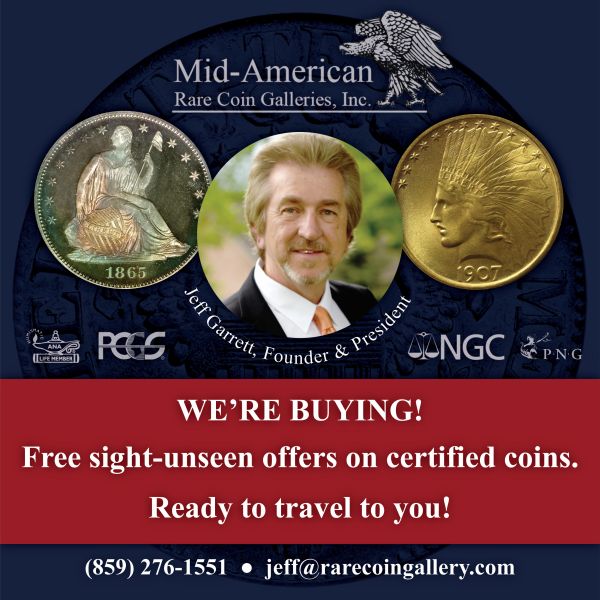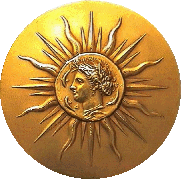
Visit our NBS Sponsors




About UsThe Numismatic Bibliomania Society is a non-profit association devoted to the study and enjoyment of numismatic literature. For more information please see our web site at coinbooks.org SubscriptionsThose wishing to become new E-Sylum subscribers (or wishing to Unsubscribe) can go to the following web page link MembershipThere is a membership application available on the web site Membership Application To join, print the application and return it with your check to the address printed on the application. Print/Digital membership is $40 to addresses in the U.S., and $60 elsewhere. A digital-only membership is available for $25. For those without web access, write to: Charles Heck, Treasurer AsylumFor Asylum mailing address changes and other membership questions, contact Chuck at this email address: treasurer@coinbooks.org SubmissionsTo submit items for publication in The E-Sylum, write to the Editor at this address: whomren@gmail.com BUY THE BOOK BEFORE THE COINSale CalendarWatch here for updates! |
- WAYNE'S WORDS: THE E-SYLUM JANUARY 15, 2023
- NEW BOOK: GOLD COINS OF ANGLO-SAXON ENGLAND
- NEW BOOK: BEAUTIFUL BANKNOTES OF FRANCE
- NEW BOOK: THE SHORT SNORTER PROJECT
- NUMISMATIQUE ASIATIQUE DECEMBER 2022
- CHARLES L. VICKERS (1937-2022)
- ANA MONEY TALKS & THE MARTIN LUTHER KING, JR. MEDAL
- VIDEO: Q. DAVID BOWERS
- THE ORIGINAL AND THE SECOND
MR. RED BOOK
- INTRODUCING COLONEL JEFF GARRETT
- ANS CHAIRMAN'S FELLOWSHIPS
- NOTES FROM E-SYLUM READERS: JANUARY 15, 2023
- THE ROBBINS COMPANY DIES SALVAGED
- HISTORY OF THE ROBBINS COMPANY
- MARK HOTZ, BANK NOTE REPORTER
- VOCABULARY TERM: METAL FLOW
- CNG TRITON XXVI AUCTION RESULTS
- ARCHIVES INTERNATIONAL AUCTION 82
- NUMISMATIC AUCTIONS SALE 67 HIGHLIGHTS
- STEPHEN ALBUM RARE COINS AUCTION 45
- HOLABIRD JANUARY 2023 AUCTION SELECTIONS
- BRAZIL 6,400-REIS REGULATED GOLD COIN
- TONED AND COLORIZED COINS
- CANADA MINTS KATHLEEN "KIT" COLEMAN COIN
- CHINA TIANGONG SPACE STATION COINS
- THE NEW KING CHARLES III BANKNOTES
- LIBRARIES AND CLIMATE CHANGE
- MISS EL SALVADOR'S GOLDEN BITCOIN OUTFIT
- FEATURED WEBSITE: WESTERN PENNSYLVANIA NUMISMATIC SOCIETY
Click here to read the thin version on the web
Click here to subscribe
Click here to access the complete archive
To comment or submit articles, reply to whomren@gmail.com
Content presented in The E-Sylum is not necessarily researched or independently fact-checked, and views expressed do not necessarily represent those of the Numismatic Bibliomania Society.
WAYNE'S WORDS: THE E-SYLUM JANUARY 15, 2023
 New subscribers this week include:
Rebecca.
Welcome aboard!
New subscribers this week include:
Rebecca.
Welcome aboard!
Thank you for reading The E-Sylum. If you enjoy it, please send me the email addresses of friends you think may enjoy it as well and I'll send them a subscription. Contact me at whomren@gmail.com anytime regarding your subscription, or questions, comments or suggestions about our content.
According to The Writer's Almanac:
The British Museum opened to the public on this date in 1759. Located in the Bloomsbury district of London.
The museum was housed in a mansion, Montagu House; admission was free, and by appointment only, to "all studious and curious Persons." Anthony Trollope once said, "When a man wants to write a book full of unassailable facts, he always goes to the British Museum."
This week we open with three new books, a periodical issue, an obituary, updates from the Newman Numismatic Portal, and more.
Other topics this week include French banknotes, ANA Money Talks, Dave Bowers, Richard Yeoman, Ken Bressett, Mark Hotz, the Robbins Company, metal flow, auction previews and results, regulated gold coins, colorized coins, and the new King Charles III banknotes.
To learn more about gold coins of Anglo-Saxon England, Short Snorters, Henry A. Ramsden, Charles L. Vickers, Leon Lindheim, ANS Chairman's Fellowships, Red Quarters, the Numismatic Poets Society, Bank Note Reporter, a rare Union Civil War dog tag, a Grant Silver Peace Medal, and Miss El Salvador's money-themed outfit, read on. Have a great week, everyone!
Wayne Homren
Editor, The E-Sylum
NEW BOOK: GOLD COINS OF ANGLO-SAXON ENGLAND
Tony Abramson has published a new book on early English gold coinage. -Editor
 In 1948, Humphrey Sutherland published Anglo-Saxon Gold Coinage, the earliest truly
comprehensive catalogue of the subject matter, including the first full description of the
Anglo-Saxon coins in the Crondall hoard of 1828.
In 1948, Humphrey Sutherland published Anglo-Saxon Gold Coinage, the earliest truly
comprehensive catalogue of the subject matter, including the first full description of the
Anglo-Saxon coins in the Crondall hoard of 1828.
There has been no complete, illustrated catalogue since. Such is the glacial rate of numismatic progress on early gold.
However, in the digital era advancement is accelerating. With the increasing popularity of metal-detection in recent decades, more finds have surfaced. The Portable Antiquities scheme has facilitated recording in the public domain.. Popular metal detection websites and magazines have enabled improved access to information. Auction catalogues have broadcast high resolution images and recent results have obliterated previous records.
In an attempt to make identification swifter and more reliable and readily eliminate bogus coins, Tony Abramson, author of the ground-breaking Sceatta List, now compliments that work with a prequel – a complete and beautifully illustrated account of all recorded early English gold coinage.
This compact volume is essential for all detectorists, field liaison officers, curators, scholars, dealers, auction cataloguers and collectors.
To order, contact the author via email at t.abramson@ntlworld.com .
Here are some reader comments from Tony's website. -Editor
David Fanning, Kolbe & Fanning Numismatic Booksellers writes:
"The gold coins of Anglo-Saxon England are among the most fascinating series of the early medieval period, but they have suffered from the lack of a modern reference that takes advantage of the recent proliferation of new information and the ease with which color photographs can be integrated into numismatic books. Tony Abramson's new book provides numismatists and detectorists with an up-to-date resource on these rare and intriguing issues."
Kevin Easton writes:
"…regarding your new book, you have managed to put it in a format that works, not just for academics, but also for someone like myself who is interested in a whole manner of old and ancient finds. Everything is easily explained, with excellent images. I've been metal detecting for 30-odd years now, and would have loved to have had a book like this when I had just started detecting. It's a must, as you just don't know when one of these special little coins will turn up."
To visit Tony's website, see:
GOLD COINS OF ANGLO-SAXON ENGLAND
(https://www.anglo-saxon-coinage.co.uk/books/gold-coins-of-anglo-saxon-england/)
THE BOOK BAZARRE
NEW BOOK: BEAUTIFUL BANKNOTES OF FRANCE
Peter Jones has written a new book; this one is on the banknotes of France. -Editor
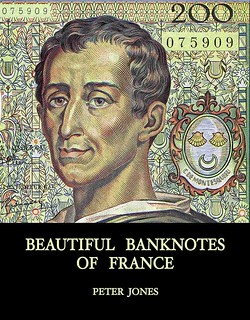 This book shows the art and stories behind fifty of the most beautiful banknotes ever produced. Called the "French touch." France printed the notes during the 1900s. The author provides full page photos of each note with details of the designer and the meaning behind the designs, with fascinating biographies and details of history and economics. An introductory chapter gives a brief history of paper money, the Mississippi bubble, and paper money during the French Revolution. The remaining seven chapters describe the notes, complete with tables, graphs, glossary and index.
This book shows the art and stories behind fifty of the most beautiful banknotes ever produced. Called the "French touch." France printed the notes during the 1900s. The author provides full page photos of each note with details of the designer and the meaning behind the designs, with fascinating biographies and details of history and economics. An introductory chapter gives a brief history of paper money, the Mississippi bubble, and paper money during the French Revolution. The remaining seven chapters describe the notes, complete with tables, graphs, glossary and index.
The format, starting on page 24, is a picture of the banknote on the right with a one page story about the note on the left.
The glossary lists Olympian gods, genealogy of gods, other allegories, mythical animals, real women on French banknotes, list of banknote designers, prix de Rome, timeline, and printing techniques.
About the author
Peter is a life member of ANA, NENA, and USMEXNA, and a member of ANS, IBSS, C4 and MCA, and president of his local coin club, the Mansfield Numismatic Society. He has also authored Notable Notes, Colonial History In Your Hands, Dow Jones by Peter Jones, Commemorative Coin Tales, The First Medals of America, The First Coins of the Americas, TREASURE! and with Prof. Cynthia Adams, Therapeutic Communication, now in its third edition. A graduate of both Oxford and Cambridge, and an MBA from the University of Connecticut, Peter moved from England with his wife and three daughters to rural Connecticut in 1977, where he practiced internal medicine for 39 years.
Book details
- Price: $49.99
- Language:English
- Pages:150
- Hardcover
- ISBN:9781667886107
Peter adds:
"I have always found the banknotes of France in the 1900s to be the most beautiful in the world and asked several dealers if there was a name for the style. But I always seemed to draw a blank. So, I started collecting them then wrote about them. I later found out the name I was looking for was "The French Touch."
I have a copy of the book and it's very well produced. The large-format book has printed glossy covers with full color throughout. The notes are well illustrated at larger-than-life size; the commentary on the notes is illustrated in color as well. There is an extensive glossary and index, making for a very handy reference. -Editor
For more information, or to order, see:
Beautiful Banknotes of France
(https://store.bookbaby.com/book/beautiful-banknotes-of-france)
NEW BOOK: THE SHORT SNORTER PROJECT
While not quite new (published in 2020), a note in yesterday's MPCGram alerted me to a book I don't believe we've mentioned before - Tom Sparks' book on Short Snorters, which is available on the Newman Numismatic Portal. We featured Tom's website in 2015. Tom will be a keynote speaker at the upcoming MPC FEST. Here's the MPCGram article as an introduction. -Editor
 The keynote speaker will be Tom Sparks, noted numismatist and founder of the non-profit educational Short Snorter Project. He is a graduate of The United States Merchant Marine Academy, then had a long career in the shipping and aviation industries. His interest in military history was fueled by grandfathers who both served in World War One, a father and two uncles who served in World War Two, and the Arlington dairy farmer, George Grimm, who was the US Naval Transport Service (NATS) pilot who flew Fleet Admiral Chester Nimitz into Tokyo Bay for the surrender of the Japanese. The Grimm short snorter was Sparks' introduction to the tradition. This short snorter, begun by Grimm's flight instructor and presented to him when he graduated, has signatures of his flight school classmates, as well as many notable WWII figures, including Admiral Nimitz.
The keynote speaker will be Tom Sparks, noted numismatist and founder of the non-profit educational Short Snorter Project. He is a graduate of The United States Merchant Marine Academy, then had a long career in the shipping and aviation industries. His interest in military history was fueled by grandfathers who both served in World War One, a father and two uncles who served in World War Two, and the Arlington dairy farmer, George Grimm, who was the US Naval Transport Service (NATS) pilot who flew Fleet Admiral Chester Nimitz into Tokyo Bay for the surrender of the Japanese. The Grimm short snorter was Sparks' introduction to the tradition. This short snorter, begun by Grimm's flight instructor and presented to him when he graduated, has signatures of his flight school classmates, as well as many notable WWII figures, including Admiral Nimitz.
Mr. Sparks' father introduced him to coin collecting in 1966 and The Numismatist introduced him to Short Snorters in 2002. He began his mission to educate the general public about the short snorter tradition in 2007 by launching a website which resulted in a flood of information and access to artifacts. His presentation will showcase the short snorter of Major General Clayton Lawrence Bissell, US Army Air Service, who was an ace pilot in the 148th Aero Squadron during World War I, and was Assistant Chief of Staff for Air Intelligence, War Department General Staff during WWII. He later was Head of the War Department Historical Program. His short snorter is 64 feet long, consists of 141 banknotes (including sets of rare Allied Military Currency perforated specimens) and is signed by over 100 Allied generals, admirals, and senior political figures of that era.
His fascinating book, The Short Snorter Project: Still Keeping the Memories Alive, is full of short snorter stories and images.
The MPC Gram is an email newsletter for collectors of Military Payment Certificates and other military numismatica. To subscribe to the MPC Gram, see: https://guide.us13.list-manage.com/subscribe?u=10eb366ab80344a56657e0d5d&id=58874b37e1 .
Helen-Louise Boling passed along this press release about the upcoming MPC Fest. -Editor
MPC Fest bourse, Friday March 18th, is free and open to the public
Roger Urce has assumed chairman responsibility for the David Seelye Military Numismatics bourse. This event is always on the Friday of Fest which for Fest 2023 is March 18. Hours are 1000 hours (10 AM Eastern time) to 1400 hours (2 PM Eastern). As always, this bourse offers free admission to the public. The Seelye bourse is unique in that it is a Friday only, one-day event that features exclusively military numismatic items. Of special interest are military payment certificates, Allied military currency, Japanese invasion money, war bonds and all other numismatic items related to World War II and other conflicts. Collectors from as far away as the Atlantic coast have travelled to Port Clinton to attend this unique event.
The bourse is named for the late David Seelye who was the founder and driving force behind the event before his death in March of 2020. A noted collector and dealer specializing in military numismatics and most recently camp chits, he is the author, with David Frank of The Complete Book of World War II USA POW & Internment Camp Chits.
Bourse chair Roger Urce announced a 50% sale of 2023 bourse tables. The bourse fee for reservations made in January will be only $50! Contact Urce at stjasele@optionline.net.
To read the book on the Newman Portal, see:
The Short Snorter Project: Still Keeping the Memories Alive
(https://nnp.wustl.edu/library/book/587732)
To read the earlier E-Sylum article, see:
FEATURED WEB SITE: THE SHORT SNORTER PROJECT
(https://www.coinbooks.org/esylum_v18n09a39.html)
NUMISMATIQUE ASIATIQUE DECEMBER 2022
Here are the contents of the latest issue of Numismatique Asiatique. -Editor
ÉDITORIAL
Collectionner les monnaies sino-mandchoues
Collecting Sino-Manchu coins
Ch'ing Cash, le magnum opus de Werner Burger
par Joe Cribb
Werner Burger, une courte biographie
Some testimonials from specialist numismatists
by V. Belyaev, B. Griffith, D. Hartill, A. Ivlev, Tong Yu
JAPAN
Henry A. Ramsden and His Ties to Other Counterfeiters
of Japanese Coins
by Craig Greenbaum
BURMA
Some new findings on King Mindon coins : Lead coins
by Valerii V. Gaganov
INDOCHINE
Notes sur le sou de zinc et ses divisions (suite)
par Daniel Cariou
MEDAILLES / INDOCHINE
Trois médailles pour trois sister-ships d'Indochine
par François Joyaux
ARCHIVES / INDOCHINE
Les décorations annamites du capitaine Jullien
BIBLIOGRAPHIE
New Coins Books Printed in Vietnam
by Craig Greenbaum
For more information, or to subscribe, see:
https://sites.google.com/site/societedenumismatiqueasiatique/adhesion?pli=1
CHARLES L. VICKERS (1937-2022)
E-Sylum Feature Writer and American Numismatic Biographies author Pete Smith submitted this article on U.S. Mint sculptor/engraver Charles L. Vickers, who passed away last month. Thanks. Thanks also to Jim Licaretz for notifying us and to Norma Vickers for providing additional photos. -Editor
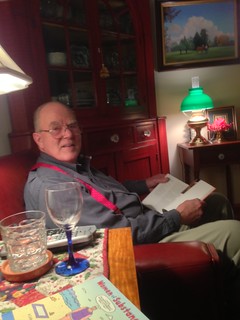 Charles L. Vickers sculpted many coin designs during his years as a sculptor/engraver for the U.
S. Mint. He was born in Camp County, Texas, on July 16, 1937, the son of a building contractor,
Horace Ellington Vickers (1904-1971) and Ellie Lawrence Vickers (1906-1993).
Charles L. Vickers sculpted many coin designs during his years as a sculptor/engraver for the U.
S. Mint. He was born in Camp County, Texas, on July 16, 1937, the son of a building contractor,
Horace Ellington Vickers (1904-1971) and Ellie Lawrence Vickers (1906-1993).
Vickers served in the United States Army with the 101st Airborne Division from 1957 through 1959. He studied at the Art Students League and Frank Reilly School of Art, the Pratt Institute and the School of Visual Arts. He was a member of the American Institute of Graphic Arts.
A job with the Franklin Mint had him move to Philadelphia in 1976. He started a studio there in 1985. Also in 1985, he was employed as a senior graphic designer for Thomas J. Paul, Inc.
The reverse of the Lincoln Memorial cent was changed in 2009. The Philadelphia Inquirer had an article on September 23, 2008, featuring Vickers and his design for one of the new reverses.
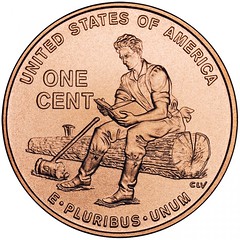
As a teen, Charles Vickers, a sculptor/engraver for the U.S. Mint in Philadelphia, had to split firewood
using a wedge and a wood-headed hammer called a maul.
So, a few years ago, when the mint assigned him to submit one of four new designs for the penny, an
image immediately came to the Jenkintown gentleman's mind: Lincoln reading a book while taking a
break from splitting logs with a double-banded maul.
Charles Vickers sculpted the models for these coins during his career as sculptor-engraver at the United States Mint December 29, 2003, until retirement on March 31, 2016:
- 2005 50 State Quarters Minnesota (sculptor)
- 2006 Benjamin Franklin Commemorative Coin Scientist reverse (designer and sculptor)
- 2006 San Francisco Old Mint Commemorative Gold Obverse (designer)
- 2006 50 State Quarters Nebraska reverse (sculptor)
- 2005 Marine Corps 230th Anniversary Silver Dollar reverse (sculptor)
- 2007 First Spouse Gold Coin and Medal Program Thomas Jefferson's Liberty reverse (designer and sculptor)
- 2007 John Adams Presidential $1 Coin obverse (sculptor)
- 2007 Little Rock High School Commemorative Coin Silver Obverse (sculptor)
- 2007 Jamestown Commemorative Coin Silver Reverse (sculptor)
- 2007 50 State Quarters Washington reverse (sculptor)
- 2008 Elizabeth Monroe First Spouse Gold Coin and Medal Program reverse (sculptor)
- 2008 Bald Eagle Commemorative Coin Clad Reverse (sculptor)
- 2008 American Eagle Platinum Coin reverse (sculptor)
- 2008 50 State Quarters Alaska reverse (sculptor)
- 2009 Anna Harrison First Spouse Gold Coin and Medal Program reverse (sculptor)
- 2009 Margaret Taylor First Spouse Gold Coin and Medal Program obverse (sculptor)
- 2009 James K. Polk Presidential $1 Coin obverse (sculptor)
- 2009 Lincoln Bicentennial One-Cent Coin Formative Years in Indiana reverse (designer and sculptor)
- 2009 District of Columbia and U.S. Territories Quarters Program American Samoa reverse (sculptor)
- 2010 Jane Pierce First Spouse Gold Coin and Medal Program reverse (sculptor)
- 2010 Franklin Pierce Presidential $1 Coin obverse (sculptor)
- 2010 Native American $1 Coin reverse (sculptor)
- 2010 Boy Scouts of America Centennial Silver Dollar obverse (sculptor)
- 2011 Julia Grant First Spouse Gold Coin and Medal Program reverse (sculptor)
- 2011 America the Beautiful Quarters Glacier Park National Park reverse (sculptor)
- 2011 U.S. Army Commemorative Coin Clad Obverse (sculptor)
- 2012 Caroline Harrison First Spouse Gold Coin and Medal Program reverse (sculptor)
- 2012 America the Beautiful Quarters Hawaii Volcanoes National Park reverse (designer and sculptor)
- 2013 Ellen Wilson First Spouse Gold Coin and Medal Program obverse (sculptor)
- 2013 Helen Taft First Spouse Gold Coin and Medal Program reverse (sculptor)
- 2014 America the Beautiful Quarters Arches National Park reverse (sculptor)
- 2014 America the Beautiful Silver Bullion Coin Arches National Park reverse (sculptor)
- 2015 First Spouse Gold Coin and Medal Program Bess Truman reverse (sculptor)
Congressional Gold Medals
- 2003 Briggs vs. Elliott & Brown vs. Board of Education Congressional Gold Medal obverse (designer and sculptor)
- 2008 Code Talkers Recognition Congressional Gold Medal Santee Sioux Nation reverse (designer and sculptor)
- 2008 Code Talkers Recognition Congressional Gold Medal Comanche Nation obverse (sculptor)
- 2008 Code Talkers Recognition Congressional Gold Medal Yankton Sioux Tribe reverse (designer and sculptor)
- 2008 Code Talkers Recognition Congressional Gold Medal Oneida Nation obverse (designer)
- 2010 Nisei Soldiers of World War II obverse (sculptor)
Private Medal Commissions
- Official medal of the Ronald Reagan Library
- Ronald Reagan Four Pillars of Freedom medal set
- USS Ronald Reagan christening medal
- USS Ronald Reagan Captain's medal
- Pope John Paul II 25 th Anniversary medal
- 2001 George W. Bush inaugural medal
After leaving the Mint, Vickers signed coin labels for NGC. Poor health with Parkinson's limited his activities in recent years. He died on December 30, 2022, and is survived by his wife, Norma and son Jamie.
What a prolific artist! Vickers will be buried in the Long Island National Cemetery in New York. His son Jamie Vickers works in the animation industry in LA. While his Selective Service and Driver's License cards show his middle name as "Lesley", Pete notes that other official records show "Lessie" as his middle name. -Editor
To read an earlier E-Sylum article, see:
SCULPTOR-ENGRAVER VICKERS RETIRES FROM MINT
(https://www.coinbooks.org/esylum_v19n15a11.html)
ANA MONEY TALKS & THE MARTIN LUTHER KING, JR. MEDAL
Newman Numismatic Portal Project Coordinator Len Augsburger provided the following report inspired by the recent addition of recordings of the American Numismatic Association's Money Talks radio spots. Thank you. -Editor
ANA Money Talks & The Martin Luther King, Jr. Medal
In 1992, the ANA launched a series of two-minute radio spots, Money Talks, which were offered at no cost to radio stations throughout the country. Several hundred outlets picked up the daily segments, and frequent authors included David Vagi, Gerald Tebben, Scott Rottinghaus, Bill Jones, Mark Van Winkle, Kerry Wetterstrom, and other familiar names. These well-written pieces featured popular topics and were intended for a non-specialized audience. The January 18, 1993 episode highlighted Martin Luther King, Jr. and was written by Ralph Ross, today the ANA President. Ross noted that numismatic tributes to King were few, and that the U.S. Mint had not released any medals or coins related to King.
On May 4, 1968, shortly after the assassination of King, the Assistant Secretary of the Treasury, Robert A. Wallace, addressed the New York Numismatic Convention. He spoke in favor of a gold medal honoring Martin Luther King, Jr., and these remarks were captured in a U.S. Treasury press release. Despite the good intentions, a congressional medal was not presented to the King family until 2014, under public law 108–368, which awarded a gold medal to Martin Luther King, Jr. and his wife Coretta Scott King. This gold medal today resides in the National Museum of African American History and Culture, gifted by the King family in 2014. The medal depicts Martin Luther King, Jr. and Coretta Scott King and remains available from the U.S. Mint in small (1.5", $20) and large (3", $160) bronze formats.
I had these tapes in my library and recently sent them to Len for digitization. This was an excellent program and a great way to promote numismatics in general and the ANA in particular. I wrote a couple of the scripts - "Communion Tokens" (No. 154) aired May 6, 1993; I also wrote "Japanese Internment Camp Tokens" which isn't captured yet on NNP. Does anyone have recordings from other years? How long did the Money Talks program continue? It was a forerunner of today's podcasts, and could be repurposed as a podcast for today's numismatic listening pleasure. -Editor
Image: U.S. Mint medal depicting Martin Luther King, Jr. and Coretta Scott King
Link to ANA Money Talks for January 18, 1993, written by Ralph Ross:
https://archive.org/details/anamt1993january18
Link to ANA Money Talks (1992-1993):
https://nnp.wustl.edu/library/multimediadetail/548250
Link to U.S. Treasury Press Releases:
https://nnp.wustl.edu/library/publisherdetail/543206
Link to Smithsonian catalog record for the Congressional gold medal for Martin Luther King, Jr. and Coretta Scott King:
https://nmaahc.si.edu/object/nmaahc_2014.135abc
VIDEO: Q. DAVID BOWERS
The David Lisot Video Library on the Newman Numismatic Portal can be found at:
https://nnp.wustl.edu/library/multimediadetail/522852
We highlight one of his videos each week in The E-Sylum. Here's another one from 1986, this time an interview with dealer and author Q. David Bowers. -Editor
ANA Numismatic Personality: Q. David Bowers David Lisot, Interviewer.
He attended the 1955 American Numismatic Association Convention at 15 years old, where he had a bourse table and met many U.S. numismatic personalities including dealers Abe Kosoff, Abner Kreisberg, and B, Max Mehl. Everyone was happy to answer his beginner questions, and ever since Dave has paid it forward by answering questions from new collectors, including yours truly.
He became a member of ANA at 16 and later served on the Board of Governors and as VP and President.
At the time of the interview his "Grandest project" was writing The History of U.S. Coins as Illustrated by the Garrett Collection. He said, "I find coins just as interesting today as when I started 30-some years ago." -Editor
To watch the complete video, see:
https://nnp.wustl.edu/library/book/557354
THE ORIGINAL AND THE SECOND MR. RED BOOK
This Whitman Publishing release is an article by Joel Orosz about two pioneering Red Book editors. -Editor
Kenneth Bressett's memoir A Penny Saved: R.S. Yeoman and His Remarkable Red Book
celebrates the life of Bressett's mentor, hobby legend Richard S. Yeo (known as R.S.
Yeoman), and the longevity of the Guide Book of United States Coins (the Red Book
), first
published in 1946. The 352-page hardcover volume is available from bookstores and hobby
shops and online (including at Whitman.com). Here, numismatic historian Joel J. Orosz
provides an appreciation of both Yeoman and Bressett.
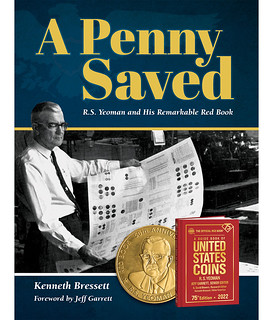 Two Whitman book series, the Handbook of United States Coins and A Guide
Book of United States Coins, both truly numismatic institutions, were the
inspiration and dedication of two men, who first established, then refined these
series for decades. One, Richard Yeo, was the founder, consummate salesman,
and ambassador; the other, Kenneth Bressett, was the scholar and developer. The
story of their joint achievement, annually renewed, is worthy of note and
remembrance.
Two Whitman book series, the Handbook of United States Coins and A Guide
Book of United States Coins, both truly numismatic institutions, were the
inspiration and dedication of two men, who first established, then refined these
series for decades. One, Richard Yeo, was the founder, consummate salesman,
and ambassador; the other, Kenneth Bressett, was the scholar and developer. The
story of their joint achievement, annually renewed, is worthy of note and
remembrance.
Richard Yeo was a son of the Badger State, blessed with a flair for design and a knack for making friends. Whitman Publishing of Racine, Wisconsin, hired Yeo in 1932 and soon put him to work selling coin boards and, later, the celebrated blue coin folders beloved by generations of young collectors. Although new to numismatics initially, he wasn't afraid to ask specialists for guidance.
As R.S. Yeoman, Yeo continued as editor of the Red Book for nearly a quarter
century, making it into the most trusted guide for retail prices and earning him the
title Mr. Red Book.
Throughout the 1960s he appeared frequently as a brand
ambassador for his many publications at coin shows, conventions, and clubs,
where he autographed books and charmed collectors with his modest demeanor
and engaging personality. By the time of his retirement in 1970, he had proven his
pen name truly apt, for his yeoman's service
benefitted not only Whitman
Publishing, but all of numismatics.
Of all of Yeoman's many achievements, perhaps the greatest was mentoring his successor.
Ken Bressett of Keene, New Hampshire, became a numismatist while in his teens.
He had printer's ink in his veins, as one of his early jobs was as a printer's devil
in the twilight years of the hot-lead printing process. In the mid-1950s Yeoman
was attending a coin show and Bressett discussed with him some questionable
items in the Guide Book. Instead of taking offense, Yeoman recognized his talent
and later engaged him as a freelance editor. Whitman hired Bressett in 1959, with
his responsibilities encompassing the Blue Book and Red Book series. By 1962 he
was made assistant editor and later managing editor in 1965, giving Yeoman more
opportunities to be a roving ambassador.
Bressett's tenure as editor lasted an astonishing 53 years; even after his formal
retirement in 2018, he has continued with special projects for Whitman. It was
natural, therefore, that following Yeoman's death in 1988, Bressett inherited the
title of Mr. Red Book.
Bressett's stewardship was lengthy, and also quietly revolutionary. He enhanced not just two book series but an extraordinarily successful and truly beloved numismatic institution. A glance at the 1966- and 2019-dated editions of both the Red Book and the Blue Book shows how vastly he (often with some behind-the- scenes help from his son, Philip) improved these iconic products. They employ similar organizational schemes, but everything from the typeface to the factual content was enriched. Page counts nearly doubled, incorporating new coin issues, and novel research expunged old errors and added important fresh findings. Timely special features were added.
Ken Bressett achieved the highly improbable: he supervised production of two successful books and for five decades simultaneously preserved and reinvented them—a seamless fusion of tradition and transformation.
Two men, two enduring book series, more than three-quarters of a century; one
shared sobriquet. Only the oldest coin collectors of 2023 can remember
numismatics without the Blue Book or the Red Book, all thanks to the
extraordinary exertions of not one Mr. Red Book
but two.
INTRODUCING COLONEL JEFF GARRETT
In his Coin Update blog, Dennis Tucker announced that the current Redbook editor Jeff Garrett is now a Kentucky Colonel. Congratulations! -Editor
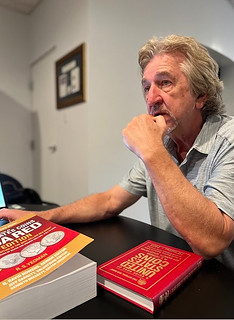 I'm pleased to devote my first
I'm pleased to devote my first From the Colonel's Desk
column of 2023 to a longtime friend and one of the newest members of the ranks of Kentucky Colonels: professional numismatist Jeff C. Garrett.
Quoting from the Governor's Office, The highest honor awarded by the Commonwealth of Kentucky is that of Kentucky Colonel.
The Honorable Order of Kentucky Colonels further defines the award as recognition of an individual's noteworthy accomplishments and outstanding service to our community, state, and nation.
I recommended Jeff's commission last fall to Governor Andy Beshear. He was granted the governor's official letters patent as a Kentucky Colonel on October 4, 2022.
If you're a coin collector in the United States, you probably already know Jeff Garrett, or at least you've seen his name in a hobby newspaper or magazine, or online, or on the front cover of the Guide Book of United States Coins. Here are some biographical details I shared in my nomination:
Jeff Garrett, founder of Mid-American Rare Coin Galleries in Lexington, Kentucky, is widely regarded as one of the nation's top experts in U.S. coinage. Knowledge and education are the foundations of Jeff's numismatic career. As a recognized expert among experts,
he regularly gives numismatic advice to many of the nation's largest coin dealers, publishers, museums, and institutions.
Jeff serves as an important consultant to the Smithsonian Institution's National Numismatic Collection. He advises the Smithsonian on funding, exhibits, conservation, and research, and has spearheaded many fundraising and publicity programs that have raised millions of dollars. Thanks to his work, the NNC's holdings have been exhibited to millions of Americans in Washington, D.C., and in traveling displays. (The Smithsonian is estimated to welcome 10 million visitors annually, and Jeff was instrumental in getting a new permanent Gallery of Numismatics opened on the main floor of the National Museum of American History in 2015.)
Also on the national level, Jeff has served as a governor of the congressionally chartered American Numismatic Association, and as its president from 2015 to 2017. He has been a member of the prestigious Professional Numismatists Guild (PNG) since 1982, and has held its office of president.
Jeff's presence is well known in the Commonwealth of Kentucky. He founded Mid-American Rare Coin Galleries in Lexington in 1984. The firm has been in the same location for more than 30 years. He started the Bluegrass Coin Club, one of the region's most active numismatic groups, in 1994. With more than 45 years of professional experience, he has personally bought and sold nearly every type, variety, and date of U.S. coin ever minted. His companies combined have annual sales in rare coins and precious metals of more than $25 million.
Jeff Garrett has authored and coauthored many numismatic books, including the award-winning Encyclopedia of U.S. Gold Coins, 1795–1933; the popular 100 Greatest U.S. Coins (now in its fifth edition); and United States Coinage: A Study By Type. He is Senior Editor of the Guide Book of United States Coins, the best-selling coin book of all time (with more than 25 million copies sold since 1946). In July of 2022, he hosted a numismatic Editorial Summit in Lexington with Whitman Publishing president Mary Burleson, publisher (and Kentucky Colonel) Dennis Tucker, and senior editor Diana Plattner.
To read the complete article, see:
From the Colonel's Desk: Introducing Colonel Jeff Garrett
(https://news.coinupdate.com/from-the-colonels-desk-introducing-colonel-jeff-garrett/)
ANS CHAIRMAN'S FELLOWSHIPS
The ANS is offering fellowships to qualified graduate students and scholars. Here's the announcement. -Editor
 The American Numismatic Society is pleased to announce the inauguration of the Chairman's Fellowships for Numismatic Research.
The American Numismatic Society is pleased to announce the inauguration of the Chairman's Fellowships for Numismatic Research.
Beginning in 2023, the ANS will award a limited number of fellowships each year, worth between $1,500 and $2,500 each, to qualified graduate students or scholars pursuing serious numismatic research projects that are expected to result in academic publication.
Proposals for funding should provide an overview of the research project, a brief timeline for the work, communicate how the results of the research will be disseminated (journal article, book, etc.), and clearly indicate how fellowship funds will support the work (research travel, image reproduction fees, etc.).
Applicants must be ANS members or fellows in good standing. To apply, please send a CV, proposal (not to exceed 2,500 words), and budget to ANS@numismatics.org. Applications will be accepted on a rolling basis. Successful applicants will be asked to give a lecture (via Zoom) on their research to the ANS membership.
For more information on the American Numismatic Society, see:
https://numismatics.org/
THE BOOK BAZARRE
NOTES FROM E-SYLUM READERS: JANUARY 15, 2023
Confirming the Red Quarter Story
Edwin Johnston writes:
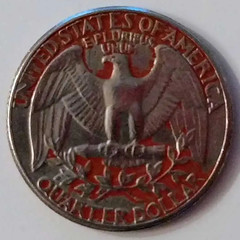 "When I was a kid in the mid-1960s the jukebox at the bar/restaurant by
the bay kicked back an occasional silver quarter painted with red nail
polish. I would think it served a similar purpose as that described for
arcades."
"When I was a kid in the mid-1960s the jukebox at the bar/restaurant by
the bay kicked back an occasional silver quarter painted with red nail
polish. I would think it served a similar purpose as that described for
arcades."
Chriss Hoffman writes:
"I can also confirm the "house quarters" call on the painted red quarters, I managed a large video arcade for Bally's in Colorado called the "Goldmine Arcade" we painted 200 or $50 worth of quarters with Krylon red spray paint one time to use in machines as replacements or free plays, these red quarters were not counted in our weekly accounting and were also subtracted from the machine's play counts. If I recall it was around 1984 so all the quarters I painted would have been older than 1985 the arcade closed down I believe in the later 1980's so if they still were doing it none of the ones in the Denver, Colorado area we painted would be older than 1989."
Thanks for the confirmation! -Editor
To read the earlier E-Sylum article, see:
THE MYSTERY OF THE RED QUARTERS
(https://www.coinbooks.org/v26/esylum_v26n02a24.html)
More on the French Brothel Token
"I believe "with mirrors" would be the proper translation."
Serge Pelletier writes:
"You are quite right to say the monnaie de singe
translates into monkey currency
, as well as monkey money
, and monkey coin
. The term monnaie de singe
means worthless money, making this piece a token or a check. Monkey business does not have a same meaning when translated in French, it rather means scheme
, i.e. a dishonest plan.
As for glace
, it can be translated into ice cream
and mirror
. Given that it was a brothel, I would use the latter meaning.
My friends at cgb.fr list this piece as a brothel token, knowing them, I'm confident that they made the appropriate research before saying it is so. This is not a concocted fantasy, it's the real thing!"
Thanks, everyone. E-Sylum readers are the best. -Editor
To read the earlier E-Sylum article, see:
NUMISMATIC NUGGETS: JANUARY 8, 2023 : French Brothel Token
(https://www.coinbooks.org/v26/esylum_v26n02a19.html)
Another Numisma
Chriss Hoffman writes:
 "I own a copy of Numisma also put out by Money Tree under the Gold Leaf Press. My copy is different than any other copy I've come across so far. It's bound in a dark green cloth and numbered 44 of 71 copies. I have only seen copies of a couple softbound and the others are like your own in brown cloth hardback. I found my copy at Second Story Books online in their JPH Numismatic Collection sale several years ago. JPH is; "John Huffman"
"I own a copy of Numisma also put out by Money Tree under the Gold Leaf Press. My copy is different than any other copy I've come across so far. It's bound in a dark green cloth and numbered 44 of 71 copies. I have only seen copies of a couple softbound and the others are like your own in brown cloth hardback. I found my copy at Second Story Books online in their JPH Numismatic Collection sale several years ago. JPH is; "John Huffman"
I also purchased his copy of a bound volume of the early years of The Asylum, my introduction to the NBS and the first book I spent over a $100 on, if I recall correctly it was almost $200. A big purchase on a book I knew very little about. It got me to join the NBS and complete my collection of back issues of the NBS and led me to The E-Sylum as well!
Glad you found us! Thanks for the information and photos of your copy. Very nice. -Editor
To read the earlier E-Sylum articles, see:
JOHN HUFFMAN
(https://www.coinbooks.org/esylum_v16n06a06.html)
NOTES FROM E-SYLUM READERS: JANUARY 8, 2023 : Numisma Reprinted in 1983
(https://www.coinbooks.org/v26/esylum_v26n02a12.html)
ChatGPT Joins Numismatic Poets Society
John Phipps writes:
"Following is ChatGPT's membership card in the NPS. Print and cut-out for easy storage in a wallet. This is a very valuable card that will be needed to be admitted to NPS functions. It should be carried at all times."
Thanks - I'm so proud. Here's the poem written by the AI chatbot ChatGPT from the tech company OpenAI. -Editor
Oh E-Sylum, source of numismatic news,
A treasure trove of knowledge and views,
From ancient coins to modern mints,
Your weekly missive never disappoints.
With articles and insights galore,
You keep us up-to-date and never bore,
Your contributors are wise and learned,
Their words enlighten and never spurned.
Your discussions on coins and history,
Keep us engaged and feeling giddy,
Your subscribers, a loyal bunch,
Anticipate each weekly lunch.
Oh E-Sylum, we thank you so,
For sharing your knowledge and love of the numismatic show,
We eagerly await each issue's release,
To be entertained and to never cease
In our pursuit of numismatic bliss,
We are grateful for your weekly miss,
Long may you continue to thrive,
Oh E-Sylum, numismatic hive.
To read the earlier E-Sylum articles, see:
OH E-SYLUM, NUMISMATIC HIVE
(https://www.coinbooks.org/v25/esylum_v25n50a12.html)
CHATGPT AND NUMISMATICS
(https://www.coinbooks.org/v25/esylum_v25n51a07.html)
Query: Numismatic Descendants of Leon Lindheim?
 Dennis Tucker writes:
Dennis Tucker writes:
"I'm wondering if any of Leon T. Lindheim's children or grandchildren carried on his interest in numismatics? Lindheim was an Ohio banker who wrote a numismatic column for the Plain Dealer from 1960 into the 1980s. I know he authored at least one book compilation of his columns (Facts & Fictions About Coins, 1967). He passed away in 2004 at the age of 92 and Dick Johnson wrote a memorial piece that was published in The E-Sylum, July 25 that year."
Can anyone help? -Editor
To read the earlier E-Sylum article, see:
CLEVELAND COIN-WISE COLUMNIST DIES
(https://www.coinbooks.org/esylum_v07n30a02.html)
Query: Notations on Specimen Notes
Robert Pepping writes:
"Dear Readers
"I am currently researching Specimen Notes printed by De La Rue for the Reserve Bank of New Zealand. However the question I am posing will most probably apply to other countries' Specimen Notes. I have not been able to determine the meaning of one part of the notations written on the notes and so I am asking for any information or assistance from you.
"On many Specimen Notes the notations often include the contract date of the note order and the order number. On most Specimen Notes the order number is preceded by a letter or letters. Below are some examples cropped from a number of Specimen Notes printed by De La Rue for the Reserve Bank of New Zealand. On the top note we have the order number G126. while the second has a complex combination - HH 548/582 followed by G943. The third to fifth show other examples. I would be very grateful to anyone if they are able to let me know what these letters (G, HH, SPO and SO) mean. Many thanks."
Great question - can anyone help with this? -Editor
Seated Liberty Coin Drawing
Wayne Pearson writes:
"I looked up 'seated liberty coin drawing' and I saw this."
Hmmm, that must be a rare variety. Thanks, -Editor
THE ROBBINS COMPANY DIES SALVAGED
Heath White collects and researches stamping dies, and he recently acquired dies used by The Robbins Company to strike a wide variety of items. Here's his report. -Editor
The company commonly known as The Robbins Company (they changed ownership and names in recent years) ceased operations at their Attleboro, MA manufacturing facility in early 2022. I'm not aware of any notice of this in any publications and thought some of the readers of The E-Sylum may be interested in knowing. Many of the items manufactured by Robbins since their founding in 1892 are sought after by collectors in many areas of collectables ranging from police/fire badges, military insignia, radio premiums, aviation wings, Masonic pennies, and the 1926 World Series rings to name a few. Official medals for NASA starting with Apollo 7, all official medals and badges for the 1932 Winter Olympics in Lake Placid, military medals from the Distinguished Service Cross down are a few examples of the many notable items produced by Robbins.
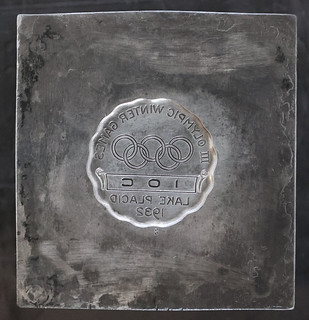 The overwhelming majority of the stamping dies used by Robbins were salvaged and I was fortunate to be able to acquire four semi-truck loads of dies. Also important is the fact that many of the company record books survived which document the provenance and other important details about the dies. I was able to digitize over 70 die ledger books which totaled several thousand pages. These document when a die was manufactured, a description of the design, who the customer was and sometimes other details like the cost of the dies. Information on production quantities, finishes applied, and price of items sold are not available.
The overwhelming majority of the stamping dies used by Robbins were salvaged and I was fortunate to be able to acquire four semi-truck loads of dies. Also important is the fact that many of the company record books survived which document the provenance and other important details about the dies. I was able to digitize over 70 die ledger books which totaled several thousand pages. These document when a die was manufactured, a description of the design, who the customer was and sometimes other details like the cost of the dies. Information on production quantities, finishes applied, and price of items sold are not available.
Above and below are images of the top and side of the die used to make official badges for the IOC members at the 1932 Winter Olympics. There were only 252 athletes from 14 nations that competed in 17 events so the quantity of badges made would be a fraction of what is required for more recent Olympics. I have seen examples of the 'CONTESTANT' badges come up for sale, but have not found examples of the IOC or OFFICIAL badges. Note, the side of the die shows the Robbins die serial number was F5343 and the date the die was manufactured, November 1931. The entry from Robbins ledger books for these dies is also shown below.
Heath welcomes inquiries from readers. His address is haw68@yahoo.com . -Editor
To read earlier E-Sylum articles, see:
FRATERNAL SUPPLIES STAMPING DIE COLLECTION
(https://www.coinbooks.org/v25/esylum_v25n11a07.html)
MORE ON INSERT DIES
(https://www.coinbooks.org/v25/esylum_v25n21a07.html)
HISTORY OF THE ROBBINS COMPANY
Here's some additional information about the Robbins Company from the Medallic Art Collector website. -Editor
Charles May Robbins (1856-1929) founded the Chas M. Robbins Company in 1892 and ran it for the next 18 years. Having become wealthy, he retired from it in 1910. In 1912 the company renamed itself to Robbins Company.
In 2007 the Robbins Company merged with the Tharpe Company to form TharpeRobbins, which renamed itself to Engage2Excel in 2015.
The Robbins Company struck many beautiful medals in the first half of the 20th century but I have very little information about it. I would be deeply grateful to anyone who can help me find out more about it. One artist who had many of his medals struck at Robbins was Julio Kilényi. Check out his medals to see more examples of Robbins' work.
The Robbins Company dies and associated records should reveal a great deal (see Heath White's report in the previous article in this issue). Here are a couple examples of Robbins company medals from Dick's site. -Editor
NBC's Tenth Anniversary 1936
by Richard A. Loederer, E.P.H. James, Julio Kilényi
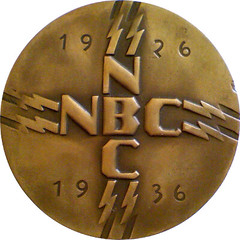 The obverse bears the old NBC logo crisscrossed in the center; double lightning bolts extending from all corners of the cross. On left and right of lightning bolts above, 19 / 26; on left and right of lightning bolts below, 19 / 36.
The obverse bears the old NBC logo crisscrossed in the center; double lightning bolts extending from all corners of the cross. On left and right of lightning bolts above, 19 / 26; on left and right of lightning bolts below, 19 / 36.
The reverse bears text only. Around, NATIONAL BROADCASTING COMPANY * A RADIO CORPORATION OF AMERICA SERVICE * ; in center field, TENTH ANNIVERSARY / TO THOSE WHO HAVE SHARED WITH US / IN THE ADVANCEMENT OF BROADCASTING.
The medal commemorates the tenth anniversary of the National Broadcasting Company which was founded in 1926. It was distributed to its employees in 1936.
New York World's Fair Medal 1939
by Julio Kilényi
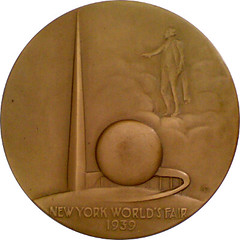 The obverse bears view of iconic Trylon and Perisphere; at upper right, a full length figure of George Washington emerges from cloud banks. At bottom, NEW YORK WORLD'S FAIR / 1939; at right, ©
The obverse bears view of iconic Trylon and Perisphere; at upper right, a full length figure of George Washington emerges from cloud banks. At bottom, NEW YORK WORLD'S FAIR / 1939; at right, ©
The reverse bears three panels; top panel shows Trylon and Perisphere over radiant sun; above, THE WORLD OF TOMORROW; the middle panel shows view of Manhattan skyline as seen from the World's Fair grounds with legend TODAY; bottom panel shows view of New Amsterdam with legend YESTERDAY; signed at top right corner of bottom panel, KILENYI
The edge bears the marks ROBBINS CO. / ATTLEBORO - BRONZE.
This was the official medal of the New York World's Fair of 1939-40. The 190m-tall spire-shaped Trylon contained the (at the time) longest escalator and the 54m-diameter Perisphere housed a diorama called "Democracity" which depicted a utopian city-of-the-future. A moving sidewalk transported spectators past the exhibits.
A much rarer version of the medal exists in which the year is 1940 rather than 1939.
The medal measures 63.5mm in diameter and was struck by the Robbins Company of Attleboro, Massachusetts.
To read the complete article, see:
The Robbins Company
(https://medallicartcollector.com/robbins-co.shtml)
MARK HOTZ, BANK NOTE REPORTER
Congratulations to Bank Note Reporter in its 50th year of publication. Columnist Mark Hotz wrote about his experience writing for the paper beginning in 1997, and his article is a great view into the history of the hobby (and changing technology as well). Here's an excerpt, but be sure to read the complete article online. -Editor
 Congratulations to Bank Note Reporter on its Golden Jubilee of service to the currency collecting community. I am delighted to have been an integral part of the Bank Note Reporter contributing team since 1997 – half of its existence! This month, as part of that celebration, I am going to reflect on my experiences writing for 25 years and how the currency market and currency collecting have changed, in my view, over that time.
Congratulations to Bank Note Reporter on its Golden Jubilee of service to the currency collecting community. I am delighted to have been an integral part of the Bank Note Reporter contributing team since 1997 – half of its existence! This month, as part of that celebration, I am going to reflect on my experiences writing for 25 years and how the currency market and currency collecting have changed, in my view, over that time.
I first got involved with Bank Note Reporter through former long-time editor David Harper, who I got to know at the annual American Numismatic Association Summer Seminars, held each summer in Colorado Springs. At that time, I was instructing courses in U.S. Large Size Currency with Gene Hessler, and later a course on U.S. National Banknotes with Peter Huntoon. David Harper was there as an emissary of Krause Publications. We became acquainted and he inquired if I would be interested in writing a column for Banknote Reporter. I found that intriguing, and so this decades long association began.
I wrote an article about a local Maryland national bank, having found the proof sheet of its notes in the Smithsonian archive. I combined illustrations of notes with pictures of the bank building in the then and now
fashion that has come to characterize my Banknote Reporter articles. This turned out to be really interesting to me, since I had always enjoyed visiting small towns and liked historic bank architecture. The response from the BNR readership was very positive, so I started with the Hotz Off the Press – Notes on National Banks theme which continues to this day.
I must admit that I am glad I went that route. I really enjoyed visiting small towns, finding and photographing the bank buildings when they were still standing, and then finding comparable vintage photos to match. Most of these came from postcard views, which at first, I bought from postcard dealers and on eBay, and later found that I could do just as well downloading the images rather than buying countless postcards.
Early on, I had to make actual trips to these small towns, so many of the articles concentrated on areas close to my Maryland residence – this included Pennsylvania, Ohio, Virginia, etc. I also tended to make special pilgrimages to banks from which I had a national bank note in my own collection. Sometimes I even took the bank note with me so that when I found the building, and sometimes could even go in, I was in some way completing a circle – the note had at one point in history emanated from that bank, and now after so many years it had completed the circle when I brought it back.
Readers often wrote to me asking if I could do articles on banks in their states, which frequently were very far away from me. With the advent of technology, this became possible, especially when Google Earth and Google Street View made it possible for me to virtually drive through small towns looking for banks and capturing photos I could use in my articles. In this way, I could present information on towns and banks that I could never practically physically visit.
As my own collecting interests matured, I sometimes found myself looking at national bank notes available at auction or at shows and deciding whether to buy a note based on whether the bank was still standing and how cute
the building was! To me, the smaller and ghostlier the town, the better the note. A national bank note from a ruined bank building or one that was abandoned was a real prize to me!
The advent of Third-Party Grading of currency, which started with Currency Grading of America (CGA) and PCGS Currency, and now is dominated by Paper Money Grading (PMG) and PCGS Banknote, has truly changed the way currency is bought and sold. Most major auction houses no longer elect to sell much in the way of ungraded currency, mainly to prevent grading disputes and to eliminate most returns. Items that are TPG graded are not returnable and this makes things a lot easier for auction firms.
Obviously, collecting national bank notes is my main interest, and that has changed also. What was once a market broken down into 50 different sub-markets by state has become a far more open space. Once a few collectors dominated any given state, and when they stopped collecting, the market for that state collapsed. This is no longer the case. A good note – whether rare or just really attractive and appealing – will find a good home regardless of location. I like a nice grade pen-signed note from just about any small town. Many collectors do not want to become pigeon-holed – stuck waiting for just a couple notes to appear to fill the few holes they have left.
The internet and Facebook groups have introduced new blood to currency and especially to national bank notes. Everyone is from somewhere, or has relatives that came from somewhere, leading them to look for notes from those towns.
To read the complete article, see:
Celebrating 50 Years of Bank Note Reporter
(https://www.numismaticnews.net/paper-money/celebrating-50-years)
Here's an excellent example of Mark's work from his December 13, 2022 article on the Pulaski National Bank of New York. -Editor
To read the complete article, see:
Ending the Year in Pulaski, N.Y.
(https://www.numismaticnews.net/paper-money/ending-the-year-in-pulaski-n-y)
VOCABULARY TERM: METAL FLOW
Here's another entry from Dick Johnson's Encyclopedia of Coin and Medal Terminology. -Editor
Metal Flow. The movement of metal in a blank at the instant of striking as it flows into the cavities of the dies under pressure during striking in a press. Metal flow is this metal movement, the result is called displacement. Metal flow occurs throughout the mass of the blank, but is most severe at and near the surface. Surface displacement is the metal flow that creates the design, where the metal flows into all the contours and cavities of both dies. Metal flow can also (but not always) cause microscopic surface striations, parallel ridges and channels, generally from the outer rim inwards as the metal is displaced to the area of the greatest cavities of the dies. These striations, flow marks, are the cause of luster, and, very infrequently, cartwheel effect.
The pressure at the instance of the blow to the blank is the power that generates metal flow. It is so strong during striking in a press that it can move metal deep within the mass of the blank. The surface metal that flows into the die cavities is replaced by adjacent metal, and this, in turn moves its adjacent metal. The movement continues until both surfaces of the blank fit the shape of both dies.
Metal flow stops at the instant the dies are fully extended and there is no more pressure. However, in rare instances, as the dies retract some metal may spring back somewhat (by molecular memory) and cause die draw. This is cured in coining with a slightly stronger impression. See also striking, suction.
To read the complete entry on the Newman Numismatic Portal, see:
Metal Flow
(https://nnp.wustl.edu/library/dictionarydetail/516305)
CNG TRITON XXVI AUCTION RESULTS
This press release from CNG discusses the auction room action when the Diocletian denio medallion was sold this week for over $2 million. -Editor
A spectacular Roman gold medallion sold to an anonymous phone bidder for $2.327 million at Classical Numismatic Group LLC's Triton XXVI auction in New York City Wednesday, shattering the record for the highest price paid for a Roman Imperial coin and electrifying a ballroom packed with onlookers.
The huge coin, a unique 10-aurei gold medallion of the Roman Emperor Diocletian (reigned AD 284-305), is larger than a U.S. $20 gold piece and nearly twice as heavy, with a powerful portrait of the emperor on the obverse and the seated figure of a muscular god Jupiter on the reverse. The largest Roman gold coin to sell at auction in well over a century, it was lot 830 and the highest-value coin in the two-day Triton XXVI auction, which realized just under $14 million total including buyer's premium, nearly double the presale estimate. The sale took place at the posh Intercontinental Barclay Hotel in Manhattan as part of the week leading up to the 51st 2023 New York International Numismatic Convention, where coin dealers and collectors gather from all over the world.
CNG auctioneer Jeff Rill expertly managed the drama-filled bidding for the piece, which started with an internet entry of $475,000 on the firm's website, www.cngcoins.com, then moved to a dwindling handful of floor bidders and two agents on cell phones representing remote bidders as the price rocketed past the $500,000 estimate and beyond the $1 million mark. Gasps escaped the audience as the price moved beyond the $1.65 million record for a Roman imperial coin, which had stood since 2008.
A tense pause stretched out for what seemed like an eternal 90 seconds after the bidding reached $1.9 million and Rill said last call,
with a phone agent holding up his paddle and the last floor bidder slowly shaking his head. The room erupted into applause and cheers when Rill finally called out, and sold for $1.9 million!
The 22.5% buyer's premium brought the medallion's final price realized to $2,327,500.
It was the highlight of my auctioneering and numismatic career so far to call the sale of this magnificent piece,
Rill said. It was amazing to look out at that truly international sea of faces packing the ballroom, hearing their hushed whispers in many different languages -- all of them focused on this one coin, this one moment, the shrinking pool of bidders, and the rising number on the screen. I will never forget it.
The medallion, termed a denio by specialists, is nearly 40mm in diameter and weighs 53.65 grams. It is believed to have been struck in AD 294 to mark Diocletian's tenth anniversary of rule. The Diocletian denio was encapsulated by Numismatic Guaranty Corporation with an extraordinary grade of Choice AU?, Strike: 5/5, Surface 5/5, Fine Style. "NGC Ancients is pleased to have handled this exciting piece, which stands out as one of the finest Roman medallions in existence," said David Vagi, head of NGC's ancients division.
The Diocletian denio is the highest-priced coin ever sold by CNG LLC in its nearly five-decade existence, said Michael Gasvoda, Managing Director. CNG is very gratified the collector who owns this amazing piece chose to consign with us,
said Gasvoda. And, of course, we are grateful to all the bidders on this piece, including the lucky winner!
I find the portrait of Diocletian on this medallion to be almost mesmerizing in its power,
Gasvoda added. We know the buyer of this superb medallion is thrilled to add it to his collection.
In addition to the Diocletian medallion, many other coins in Triton XXVI shot past the $100,000 mark (all prices include buyer's premium):
? $428,750 for lot 1067, an artistic Indian gold Heavy Mohur of the Mughal Emperor Jahangir.
? $336,875 for lot 639, and extremely rare Roman gold aureus of Mark Antony.
? $196,000 for lot 181, a beautiful Greek gold stater of Pantikapaion on the Black Sea.
? $159,250 for lot 497, a rare Greco-Baktrian silver tetradrachm of the mysterious ruler Zoilos the Just.
? $147,000 for lot 1282, a stunning 1893 Victoria Proof 5 Pounds, graded NGC Proof 66 Ultra Cameo.
? $134,750 for lot 507, a tiny Indian gold quarter-dinar of the Kushan King Kanishka, of the only ancient gold coins depicting a figure of buddha.
? $134,750 for lot 1253, an impressive gold Ship Ryal
of the English Queen Elizabeth I.
We are quite pleased for both our bidders and consignors in Triton XXVI, which turned out to be one of the most successful and memorable auctions in CNG's nearly five-decades in operation,
Gasvoda said.
To learn more about this and other ancient and world coins, or to enquire about consigning to future Classical Numismatic Group auctions, write to CNG@cngcoins.com, or call (717) 390-9194.
To read the earlier E-Sylum article, see:
CNG TRITON XXVI AUCTION ANNOUNCED
(https://www.coinbooks.org/v25/esylum_v25n49a24.html)
ARCHIVES INTERNATIONAL AUCTION 82
Here is the announcement for the January 24, 2023 sale by Archives International Auctions. -Editor
ARCHIVES INTERNATIONAL AUCTIONS OFFERS HISTORIC U.S., CHINESE & WORLD BANKNOTE COLLECTION ON JANUARY 24, 2023.
The auction will be held by Archives International Auctions at their offices in River Edge, N.J.
 The January 24th, 2023 Auction by Archives International Auctions consists
of 726 lots of rare and desirable U.S., Chinese & World Banknotes, Scripophily, Historic
Ephemera, and Security Printing Ephemera. The auction includes 426 lots of World banknotes
highlighted by 89 lots of rare and desirable Chinese banknotes and Scripophily. Also included
are over 55 lot of historic U.S. Colonial banknotes, Colonial Connecticut fiscal documents, U.S.
Obsolete banknote, Small and Large Type Notes, National Banknotes, and miscellaneous U.S.
fiscal documents. Historic and Security Printing Ephemera includes 55 lots of rare and seldom
seen items highlighted by an issued Bill of Exchange from a Charleston, South Carolina Military
Prison from a Union Civil War POW in addition to related documents; and, over 181 lots of U.S.
and World scripophily.
The January 24th, 2023 Auction by Archives International Auctions consists
of 726 lots of rare and desirable U.S., Chinese & World Banknotes, Scripophily, Historic
Ephemera, and Security Printing Ephemera. The auction includes 426 lots of World banknotes
highlighted by 89 lots of rare and desirable Chinese banknotes and Scripophily. Also included
are over 55 lot of historic U.S. Colonial banknotes, Colonial Connecticut fiscal documents, U.S.
Obsolete banknote, Small and Large Type Notes, National Banknotes, and miscellaneous U.S.
fiscal documents. Historic and Security Printing Ephemera includes 55 lots of rare and seldom
seen items highlighted by an issued Bill of Exchange from a Charleston, South Carolina Military
Prison from a Union Civil War POW in addition to related documents; and, over 181 lots of U.S.
and World scripophily.
We are privileged to offer numerous rare and desirable banknotes, historic ephemera and
bonds and shares that are rarely seen at auction and include many examples we have never
had the pleasure to offer previously
, stated Dr. Robert Schwartz, President of Archives
International Auctions. Included in our 82nd auction are hundreds of items that will appeal to
every level of collector and dealer
.
The auction begins with World Banknotes, from countries Algeria to Zambia, highlighted by 89
lots of Chinese banknotes, and bonds, with a majority of these notes from an old-time
collection being offered for the first time at auction. The China banknote section is highlighted
by a Bank of China, 1912, $1, Peking
Branch Issue rarity; Belize is represented by 1974 and
1975 high grade issued $2, $5, and $10 notes, grading between PMG Unc 64 to Unc 67; Proof
vignettes used on the Panama, Arias
, issue are offered and include the Portrait of Balboa in
green and additional titles used on other notes from that series; the National Bank of Viet Nam,
1000 Dong Specimen is offered, and, the highest graded Zambia, 1969, 1 Kwacha is offered in
PMG 68 EPQ and hundreds of other issued, proof and specimen notes are offered.
Included in the U.S. section of the auction are 6 lots of Colonial and Revolutionary U.S. period banknotes and fiscal documents from a new find; an amazing, U.S. Treasury Note, $100, Act of March 4th , 1814 remainder is offered. The Civil War and Confederate issues are highlighted by a discovery C.S.A., $10, T-68 Inverted back printing and inverted undertint on the face error, with no previous auction record discovered for this rarity; 4 different Reno, Nevada 1929 Small Type National banknotes are offered in this auction as well as dozens of other Small, Large, Obsolete, and depression scrip notes are included.
The historic ephemera section includes Alaska and California Gold Rush items; an outstanding Civil War Bill of Exchange, issued by a Union Soldier while in captivity in a Confederate POW prison in Charleston, SC is offered and should attract considerable attention. Numerous desirable Civil War and historic autograph items round out the ephemera section. Security Printing Ephemera includes 29 lots of desirable items including Advertising Notes, Progress Vignette Proofs, and numerous related items.
Some of the many scripophily highlights in the auction include issued and specimen stocks and bonds from numerous well-known banking, finance and tech companies such as a Shearson Lehman Hutton Holdings, $20 Million Registered Bond; the NYSE Group (New York Stock Exchange); Berkshire Hathaway; Bear Stearns and many other well-known and in some cases notorious companies in U.S. financial history. Additional highlights in the scripophily portion of the auction include many well-known transportation items including a ca.1920's specimen automobile share certificate from Dodge Brothers, Inc.; a Cherokee Outlet, Oklahoma Territory, 1894, $1000, U.S. Department of the Interior - Federal Related Cherokee Nation Specimen Bond rarity is included as well as numerous historic and desirable bonds and shares in various categories from mining, to railroads, to banking will be offered.
Previews will be limited and by appointment only and we will be observing strict safety precautions including the wearing of masks and observing social distancing to protect our team as well as our guests. We will do our best to accommodate anyone who desires additional information and photographs. For questions, please call 201-944-4800 or email info@archivesinternational.com.
The online catalog for the Tuesday, January 24th, 2023 auction is on Archives International Auctions' website and can be viewed via the Archives International live bidding platform. It can also be viewed as a Virtual Catalog or downloadable Sale 82.pdf on their website. To pre- register for Live Internet Bidding, log on to the Archives International Auctions website, at www.ArchivesInternational.com.
Archives International is now working on their late Winter and Spring 2023 auctions and are seeking quality consignments for future auctions or outright purchase including U.S. and worldwide banknotes, coins, stocks, bonds, stamps, postal history, historic ephemera, and autographs. To sell or consign one piece or an entire collection, please call AIA at (201) 944- 4800; or email them at info@archivesinternational.com.
You may also write to Archives International Auctions, at 1060 Main Street, River Edge, NJ 07661, U.S.A. To learn more about Archives International Auctions and the auctions planned for Winter 2023, auction, log on to www.ArchivesInternational.com.
NUMISMATIC AUCTIONS SALE 67 HIGHLIGHTS
Here are some more highlights from Auction 67 from Numismatic Auctions LLC., including a rare Civil War dog tag and some Pre-Confederation Canadian pieces. The sale opening has been pushed back a week to January 23, 2023, and the Session II online closing has been extended to February 18. -Editor
Lot 415: West Virginia Union Civil War Dog Tag
Rare Union Civil War Dog Tag on VA(West Virginia). WM, 30mm. Assigned and engraved to A.W. Lindsey, Co. G 12th Reg. Virginia Volunteers, Harrison County, VA(West Virginia). Bust of McClellan left, UNION and LIBERTY either side. Very Fine, pierced for suspension, some old marks and scrapes, primarily to the portrait side. An important and rare, seldom offered Union Dog Tag on a tougher state and one that should inspire some bidding interest for certain.
To read the complete lot description, see:
US Very Rare Civil War Dog Tag on Harrison (West) Viriginia - Sharp VF
(https://numismaticauctions.nextlot.com/auctions/1417146/lots/11327821)
Lot 437: 1948 Canada Silver Dollar
Canada Silver Dollar, 1948. Key Date. PCGS SP65 with amazing razor sharp elements, pristine glassy fields and absolutely no die burn or polish on the hair or cheek obverse. Ex: Belzberg Collection with a mint condition example of the original hardbound catalog, this coin was first ICCS graded SP66 by Brian Cornwell for Sid Belzberg. Truly a memorable 1948 Specimen Dollar!
To read the complete lot description, see:
Canada Silver Dollar 1948 Key Date Specimen PCGS SP65 Ex: Belzberg
(https://numismaticauctions.nextlot.com/auctions/1417146/lots/11352181)
Lot 465: Hudson's Bay Company 1 Made Beaver Token
Canada Pre-Confederation Token, Hudson's Bay Company East Main – 1 MB (Made Beaver – NB Die Cutter Error on Token), ND(1857). NGC MS63, fully original with trace iridescence and only one graded higher. Yet another from this rare issue, nice companion piece to the previous lot and seldom available.
To read the complete lot description, see:
Canada Pre-Confederation Hudson's Bay Company 1 Made Beaver NGC MS63 Beauty
(https://numismaticauctions.nextlot.com/auctions/1417146/lots/11352377)
Lot 471: 1820 Lower Canada Half Penny
Canada Pre-Confederation Token, Lower Canada ½ Penny, 1820. LC-60C2, Br-1012. PCGS Gold Shield Secure MS65 with lovely red and brown luster. Consignor notes as Top Pop. Impressive condition.
To read the complete lot description, see:
Canada Pre-Confederation Lower Canada 1/2 Penny 1820 LC-60C2 PCGS MS65 Top Pop
(https://numismaticauctions.nextlot.com/auctions/1417146/lots/11352419)
STEPHEN ALBUM RARE COINS AUCTION 45
Here's the press release for Stephen Album Rare Coins upcoming Auction 45. -Editor
 Stephen Album Rare Coins will hold its Auction 45 on January 26-29, 2023 at its offices in Santa Rosa, California. The Auction is made up of 3,355 lots of Ancient, Islamic, Chinese, Indian, and General World Coins. The combined low/high estimate is $1.5 to $2.0 million USD, with the final total expected to far exceed the high estimate amount.
Stephen Album Rare Coins will hold its Auction 45 on January 26-29, 2023 at its offices in Santa Rosa, California. The Auction is made up of 3,355 lots of Ancient, Islamic, Chinese, Indian, and General World Coins. The combined low/high estimate is $1.5 to $2.0 million USD, with the final total expected to far exceed the high estimate amount.
Featured in the sale is the Joe Sedillot Collection of World Coins (Part IV) which includes a wide array of type coins from numerous countries. A significant number of the coins in the collection are in choice condition and were selected for encapsulation in PCGS holders. Parts I through III were offered in the firm's auctions in 2022. Many pieces went for multiple times estimate and some items set new price records. Part IV largely consists of European coins from countries starting with A through P. Additional parts of the collection will be offered in subsequent auctions in 2023.
Some highlights from the sale follow:
LOT 194
UMAYYAD: al-Walid I,
705-715, AR dirham (2.35g), 'Uman (Oman), AH90, A-128, Klat-500, Umayyad dirhams dated AH81 and 90 are the earliest Islamic coins struck in Oman, attractive VF, RRR
For the year AH90, there are now 4 confirmed examples: (1) Oman Currency Museum, published by Robert Darley-Doran, History of Currency in the Sultanate of Oman, in 1990 (page 129, with enlarged illustration on page 14), which is same piece published by John Walker as "Ties.16", originally published by Otto Blau & J.C. Stickel in Zur muhammedischen Numismatik… in 1857 (also illustrated by Shams-Eshragh as his #722) (2) in the collection of Michel Klat, which he published and illustrated as #500 with the code OHF in Catalogue of Post-Reform Dirhams… in 2002, page 190 (3) an example sold by Morton & Eden in their Auction 48, Lot 35 (April 2011), also illustrated as Zeno-97537; and (4) this piece offered in Stephen Album Rare Coins Auction 45.
ESTIMATED VALUE $250,000 TO $300,000
LOT 1032
BRITISH INDIA: George V,
1910-1936, 4-coin proof restrike set, 1911(c), Bombay Mint proof restrikes, a lovely set of this rare one-year type including AR 2 annas NGC graded PF-62, AR ¼ rupee NGC graded PF-63, AR ½ rupee PCGS graded PF-63, and AR rupee NGC graded PF-63, set of 4 coins
ESTIMATED VALUE $27,000 TO $30,000
LOT 1496
GREAT BRITAIN: Victoria,
1837-1901, AR crown, 1847, KM-744, S-3883, Esc-2571, 'Gothic' type, 'UNDECIMO' on edge variety, a wonderful proof quality example with light attractive toning! PCGS graded Proof 64, ex Joe Sedillot Collection.
ESTIMATED VALUE $15,000 TO $20,000
LOT 940
JUBBAL: Raja Rana Sir Bhagat Chand Bahadur,
1910-1947, AV mohur, VS1988 (1931), Bruce-X2, F-1238, State coat-of-arms with lion supporters within linear circle; in outer margin, jubal rajya (Jubbal State) in Nagari above, date below; floral symbols flanking date // sri (Lord) within linear hexagram; all within linear circular border; sri sri sri ramacandri jayati (venerable Lord Sri Ramachandra is victorious) in Nagari, an attractive mint state example of this very rare type! PCGS graded MS61, RR.
ESTIMATED VALUE $10,000 TO $15,000
LOT 1198
KIRIN: Kuang Hsu,
1875-1908, AR dollar, CD1901, Y-183a.1, L&M-536; K-425; WS-0430, variety with regular "S" in CANDARINS, touches of luster, a scarce variety, PCGS graded AU53, S.
Tied with two other examples for second finest at PCGS.
ESTIMATED VALUE $10,000 TO $12,000
LOT 1396
AUSTRIA: Franz Joseph I,
1848-1916, AR gedenkthaler, 1877, KM-M9, Y-A20. Dav-30, Opening of the High Alpine Cottage in the Rax Range by Archduke Karl Ludwig, mintage of only 100 pieces! PCGS graded Specimen 64 DCAM, RR, ex Joe Sedillot Collection.
ESTIMATED VALUE $8,000 TO $10,000
LOT 1203
SZECHUAN: Kuang Hsu,
1875-1908, AE 10 cash, ND (1903-05), CL-SC.76, pattern type with finer engraved dragon and horizontal flame above pearl, superb strike with wire rim either side, PCGS graded Specimen-55, RRR.
An extremely rare pattern with only one other example in Specimen quality that we can find in a public auction.
ESTIMATED VALUE $4,000 TO $6,000
LOT 1663
PERU: Felipe V,
1700-1746, AV 8 escudos cob (26.95g), 1711, KM-38.2, Calico-2119, assayer M, from the 1715 Plate Fleet wrecks, with custom folder, PCGS graded AU58.
ESTIMATED VALUE $4,000 TO $5,000
SARC COO Mike Barry commented: We saw a significant increase in our sales figures in 2022 with each sale continuing to break records both in terms of prices and bidding activity. We expect the trend to continue as we head in to 2023. We have numerous interesting collections in the pipeline that should continue to attract our loyal bidders.
The firm is now taking consignments for future premier and online auctions.
More information can be found on their website at www.stevealbum.com
HOLABIRD JANUARY 2023 AUCTION SELECTIONS
Here are some lots that caught my eye in the upcoming Holabird Americana sale. -Editor
Lot 1101: Kansas Hotel & I.D. Tags
Lot of five medals: brass tag from the New Eldridge hotel of Lawrence Kansas (#18). Four I.D. tags: W. H. Mills, Damar; J. A. Alman, McPherson; Chas. Cox, Clyde; Barney Gallagher, Stockton.
Interesting little group; these tags are similar in manufacture to charge coins. -Editor
To read the complete lot description, see:
Kansas Hotel & I.D. Tags [159977]
(https://holabirdamericana.liveauctiongroup.com/Kansas-Hotel-I-D-Tags-159977_i47378796)
Lot 1139: Osage Trading Company Billhead & Scrip
Lot of 2. Osage Trading Company, Dealers in General Merchandise and Miners' Supplies, Krebs, Indian Territory. Includes a 1905 full page billhead plus 5 cent scrip for the store dated 1897. Scrip has condition issues. Rare Indian trader pair and rare advertising for mining supplies in Indian Territory. DH Hailey (who signed the scrip) was a coal mining figure who opened mines at Haileyville and at Wilburton, operating under the name of Hailey-Ola Coal Company. He took over the Osage Trading Company in the 1880s. Krebs was a coal-mining town in the Choctaw Nation of Indian Territory, now Pittsburg County, Oklahoma.
A nice pair for exhibiting. Scarce scrip. -Editor
To read the complete lot description, see:
Osage Trading Company Billhead & Scrip, Indian Traders, Krebs, IT [158043]
(https://holabirdamericana.liveauctiongroup.com/Osage-Trading-Company-Billhead-Scrip-Indian-Traders-Krebs-IT-158043_i47378835)
Lot 1027: Day The Earth Stood Still Lobby Poster
c. 2000 reprint of this beautiful lobby poster. Will make a great display piece from this futuristic thriller. On backing board and no creases. 148 in lower left corner. 41x27".
OK, non-numismatic, but I couldn't resist. Sorry to see that it's a reprint, but still a classic poster for a classic film.
I think I was playing poker with friends when I won a large pot, prompting numismatic literature dealer "Big John" Burns to scowl and literally growl at me. I said, "Klaatu! Barada! Nikto!" He laughed and I lived for another day. If the line doesn't ring a bell, watch the movie someday. -Editor
To read the complete lot description, see:
Day The Earth Stood Still Lobby Poster [159617]
(https://holabirdamericana.liveauctiongroup.com/Day-The-Earth-Stood-Still-Lobby-Poster-159617_i47378722)
Lot 3210: CdV and Postal Covers for Isaac Edwards Clarke
This frame is a collection of two CdVs of Colonel Isaac Edwards Clarke of the Union Army. He worked in London with George Peabody a banker and philanthropist before the Civil War. Later, became Provost Marshall of New Orleans during the war. There are two CdVs of I.E. Clarke, two cover letters to/from him (1859, 1860) and one Pass from the Provost Marshal General's office of Louisiana date January 31st, 186(5). Two pieces of Confederate paper money are also shown. He was responsible for confiscating Confederate goods. Framed at 9 in. X 21 in. Please see photo for details.
Interesting group, nicely framed for display. -Editor
To read the complete lot description, see:
CdV and Postal Covers for Isaac Edwards Clarke 1859-1860 [157377]
(https://holabirdamericana.liveauctiongroup.com/CdV-and-Postal-Covers-for-Isaac-Edwards-Clarke-1859-1860-157377_i47380014)
Lot 3229: Indian Wars Document and Medals
This framed document has Brig. General E.S. Godfrey's signature on an Indian Wars letterhead. General E.S. Godfrey was a Little Bighorn survivor. The frame also contains two Indian Wars champagne medals; an Indian Wars medal (1.25 in.) and a "First Reunion Gen'l. George A. Custer's Command 1861-1865" with the likeness of Custer; On the Bar is "CANANDAIGUA, N.Y./ AUGUST 21,22, 1907" (1.5 in.) . The medals are bronze and cloth. The letter is 8 in. X 9.5 in. "Cookstown, N.C. March 15, 1915/ Mr. Joseph A. Whitaker/ Marshalltown, Iowa./Dear Sir:/I have the honor to call xxxxxx xxx (illegible) your signature and it gives me pleasure to comply with your wishes. /Respectfully yours,/ E.S. Godfrey,/Brg. General U.S.A. Retired/ Commander". Framed at 12 in. X 17.5 in. Please see photo for details.
Another nice group framed for display. -Editor
To read the complete lot description, see:
General E.S. Godfrey Signature on Indian Wars Document and Medals [161234]
(https://holabirdamericana.liveauctiongroup.com/General-E-S-Godfrey-Signature-on-Indian-Wars-Document-and-Medals-161234_i47380033)
Lot 4095: Grant Silver Peace Medal
Julian IP-42. Extremely Fine - AU condition, very few marks in the field, blue toning is exquisite. Engraver: Anthony C. Paquet (1814-1882); Depicted: Ulysses S. Grant (American, 1822 ñ 1885) Silver U. S. Grant peace medal. Obv.: United States of America / "Let Us Have Peace" / Liberty Justice and Equality; rev.: One earth peace / 1871 / Good Will Toward Men. In original presentation box (which has two broken sides); holed with hanging loop; 63 mm; 112.8 grams. A distributed mintage of 300 silver examples make this a rare example of the Indian Peace medal series, but far fewer than that number have survived, Produced at the bloodiest times of the Indian Wars, these historic relics are a chapter of America's history. This medal also has the distinction of being the only Indian Peace medal upon which the name of the President does not appear.
Nice medal! -Editor
To read the complete lot description, see:
Grant Silver Peace Medal [158190]
(https://holabirdamericana.liveauctiongroup.com/Grant-Silver-Peace-Medal-158190_i47380433)
Lot 4003: $20 First National Bank of Elko, Nevada
Serial number A 000013 A, the second lowest serial number in the Census as well as the 13th note issued. There are 26 large size and 47 small size in the census. Fine condition.
Great small-sized National Bank Note. -Editor
To read the complete lot description, see:
$20 First National Bank of Elko Ch. #7743 [158196]
(https://holabirdamericana.liveauctiongroup.com/20-First-National-Bank-of-Elko-Ch-7743-158196_i47380341)
BRAZIL 6,400-REIS REGULATED GOLD COIN
An article by Chris Bulfinch on the Stack's Bowers blog has a striking image of a regiulated Brazilian coin. -Editor
No, King Joseph I's eye isn't bugging out on this 1762/1-R Brazilian 6,400-reis. The coin was plugged and stamped by John Burger, a New York assayer and coin regulator and contemporary of the famed Ephraim Brasher. Before, during and after the American Revolution in what would become the United States, a coterie of assayers regulated
gold coins – assaying and then raising or lowering their weight to the necessary level to serve in. In this time, before the establishment of the U.S. Mint, such pieces filled an acute need for coinage of a standard weight. In our Official Auction of the Whitman Coin & Collectibles 2023 Spring Expo, we are pleased to be presenting this beautiful example, graded AU-55 Countermark Unc Details by NGC, a piece that was modified to serve as an $8 coin then later clipped to meet a lighter West Indian standard.
Referred to as Half Joes
– a reference to the Portuguese rulers Johannes (to 1750) and Josephus (1750-1777) whose portraits appear on the obverse – the gold 6,400-reis coin was widely used in colonial America. Clipping, shaving, sweating
(a practice in which coins were placed in a bag, shaken, and the resulting tiny pieces of precious metal recovered) and other practices reduced the weight of gold coins so far that their stated values were of limited usefulness. Since different locales had different weight standards for gold coins, local metalsmiths played an important role in regulating coins to appropriate standards.
Regulators
used gold plugs stamped with a metalsmith's mark to bring underweight coins into line with local weight standards. Burger's mark consisted of a round or oval cartouche, into which his initials were engraved. The example we will offer in March was struck at the Rio de Janeiro mint and was plugged and stamped by Burger at some point in his regulating career, which spanned 1784 to 1805. Our cataloger notes that Regulated gold scholar Ralph Gordon considered this style of plug an assay plug, meant only to assess the fineness of the coin but not to modify the weight.
Whatever the plug's purpose, it's an important artifact of a turbulent period in our country's monetary history.
A range of colonial gold coins bear Burger's regulation stamp, which was not positively identified until the early 1990s. On this example, the plug with Burger's mark was stamped over King Joseph I's eye; it was regulated sometime around 1784, possibly as late as the mid-1790s. After 1795, there was little incentive to continue regulating, as the Mint was able to buy, melt, and re-coin world coins into official United States issues. At some point after Burger regulated this coin, it was clipped down to a lower weight standard in use in the West Indies. It lived quite a life, reflecting the complexities of transatlantic trade in the 18th century.
Our cataloger offers this detailed assessment: Neatly clipped into the tops of the letters in the obverse legend and flush to the peripheral elements of the arms on the reverse. The edge device is consistent and accompanied by a finely denticulated border added to the reverse. The coin is remarkably attractive, alternating between bright medium gold and warmer golden-orange, with tinges of intermingled olive also discernible. Hints of darker patina are evident at the left obverse and right reverse borders. The 6400 reis host coin, sometimes called a half Joe, shows a uniformly sharp strike and ideal centering. Close inspection with a loupe reveals traces of the 1 underdigit within the loop of the primary digit 2 in the date.
To read the complete article, see:
STACK'S BOWERS GALLERIES TO OFFER JOHN BURGER-REGULATED BRAZILIAN 6,400-REIS GOLD COIN IN SPRING 2023 AUCTION
(https://stacksbowers.com/stacks-bowers-galleries-to-offer-john-burger-regulated-brazilian-6400-reis-gold-coin-in-spring-2023-auction/)
TONED AND COLORIZED COINS
Last month COINage had an article by Mike Garofalo on the history of toned and colorized coins. Here's an excerpt - see the complete article online. -Editor
The popularity of coins with color on them drives certain segments of rare coin markets and collectors. Morgan Dollars, type coins, and classic commemoratives are all distinct types of numismatic coins where beautiful and original colors bring strong premiums. An ever-growing segment of the coin market appreciates natural color on coins. Non-collectors are also attracted to the colorful images, even though the coins are secondary.
In April 2004, Superior Galleries offered a beautifully toned 1926 Oregon Trail Commemorative Half Dollar, graded MS67, at a public auction in California. The coin brought $69,000. That's 34.5 times its graded value of $2,000. Why? Because of the coin's beautiful, natural and original color.
 Adding color to coins or rounds is not a new idea. The history of colorized or layered coins spans more than 30 years. In its infancy, colorized coins were hand-painted with enamel paint. I remember seeing the wonderfully patient and talented artists at a coin dealership who were adding enamel paint color to holiday silver rounds by hand with very thin special brushes. The results were excellent.
Adding color to coins or rounds is not a new idea. The history of colorized or layered coins spans more than 30 years. In its infancy, colorized coins were hand-painted with enamel paint. I remember seeing the wonderfully patient and talented artists at a coin dealership who were adding enamel paint color to holiday silver rounds by hand with very thin special brushes. The results were excellent.
Later, people began applying stickers, or appliques, to cover one side of the coin with a colorful image of the coin itself or something completely different. While these stickers were not as attractive as a hand-painted product, the stickers satisfied the demands of a mass audience.
Enterprising organizations began adding artificial color to the surface of the coin. The first colorized coins offered to the public were struck by Coin Invest Trust (CIT), a private mint in Europe after they developed a chemical and mechanical process for adding color to the coins. This process allowed them to bond the color to the metal.
 n 2004, Canada, a nation that is always progressive in its variety of inventive coinage, was the first nation to issue a colorized circulating coin. The Canadian 25 Cent Poppy coin was issued in honor of Canada's 117,000 war dead. The coin had a red poppy emblazoned across the back and a protective coating over it so the color wouldn't wear off easily. The quarter nearly caused an international spying incident when several U.S. military contractors acquired some in change and thought the coins, because of their unusual appearance, may have some type of nano-technology transmitters on them. The contractors reached out to the U.S. Department of Defense and were assured these coins were not espionage equipment.
n 2004, Canada, a nation that is always progressive in its variety of inventive coinage, was the first nation to issue a colorized circulating coin. The Canadian 25 Cent Poppy coin was issued in honor of Canada's 117,000 war dead. The coin had a red poppy emblazoned across the back and a protective coating over it so the color wouldn't wear off easily. The quarter nearly caused an international spying incident when several U.S. military contractors acquired some in change and thought the coins, because of their unusual appearance, may have some type of nano-technology transmitters on them. The contractors reached out to the U.S. Department of Defense and were assured these coins were not espionage equipment.
Since that time, the Royal Canadian Mint has utilized that technology on numerous occasions to create different colorized coins. Some of the most popular coins have been the colorized Maple Leaf silver bullion coins, with their bold, bright and seemingly natural colors.
Many people wondered when and if the United States Mint would create and issue a colorized coin. In August 2020, the Mint released a colorized coin set for the 60th Anniversary of the Naismith National Basketball Hall of Fame. These commemorative coins were truly an innovation for the ‘late-joining' U.S. Mint.
To read the complete article, see:
The History of Colorized Coins
(https://www.coinagemag.com/the-history-of-colorized-coins/)
CANADA MINTS KATHLEEN "KIT" COLEMAN COIN
This article discusses the Royal Canadian Mint's new dollar honoring Canada's first woman journalist, Kathleen "Kit" Coleman. Unusual design, but I kind of like it. Certainly different. -Editor
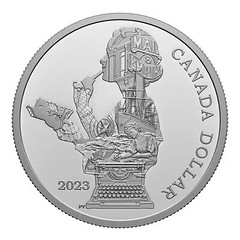 The Royal Canadian Mint has dedicated its 2023 Proof Silver Dollar to celebrating the inspiring life of Canada's first woman journalist, Kathleen "Kit" Coleman. Born in County Galway, Ireland and emigrating to Canada in 1884, Kit Coleman first joined the Toronto Daily Mail as a Women' Editor and later became North America's first accredited woman war correspondent, gaining international fame for her coverage of the aftermath of the Spanish-American War. She also helped establish the Canadian Women's Press Club, and served as its first President. Her fascinating journey is told through the artistry of Pandora Young, who used Kit's silhouette as the canvas upon which the main chapters of her life are richly illustrated on the reverse of the coin.
The Royal Canadian Mint has dedicated its 2023 Proof Silver Dollar to celebrating the inspiring life of Canada's first woman journalist, Kathleen "Kit" Coleman. Born in County Galway, Ireland and emigrating to Canada in 1884, Kit Coleman first joined the Toronto Daily Mail as a Women' Editor and later became North America's first accredited woman war correspondent, gaining international fame for her coverage of the aftermath of the Spanish-American War. She also helped establish the Canadian Women's Press Club, and served as its first President. Her fascinating journey is told through the artistry of Pandora Young, who used Kit's silhouette as the canvas upon which the main chapters of her life are richly illustrated on the reverse of the coin.
Pandora Young has fashioned another portrait of the pioneering journalist on the 2023 $100 Pure Gold Coin. The reverse features Kit Coleman writing at her desk. Behind her is a map showing North America and Europe, with dotted lines retracing her epic travels across both continents.
The Mint is also introducing an updated obverse design that will appear on 2023 collector and bullion coins until a new permanent obverse is adopted on Canadian coins. The Susanna Blunt-designed effigy of Queen Elizabeth II is accompanied by a special marking consisting of a vertical inscription of the dates "1952" and "2022", separated by four pearls symbolizing the four effigies that have graced Canadian coins throughout the reign.
To read the complete article, see:
ROYAL CANADIAN MINT INTRODUCES TRANSITIONAL EFFIGY ON 2023 PROOF SILVER DOLLAR CELEBRATING PIONEERING WOMAN JOURNALIST KATHLEEN "KIT" COLEMAN
(https://www.yahoo.com/now/royal-canadian-mint-introduces-transitional-140000923.html)
See also this Canadian Coin News article by Jesse Robitaille:
RCM opens 2023 with annual issues
(https://canadiancoinnews.com/rcm-opens-2023-with-annual-issues/)
CHINA TIANGONG SPACE STATION COINS
China has issued coins commemorating its Tiangong space station. -Editor
China's first space station is now complete in Earth orbit — and on a new set of coins.
The People's Bank of China on Monday (Jan. 9) issued gold and silver coins(opens in new tab) in celebration of the completion of the nation's Tiangong space station. The orbital complex, which was first proposed in 1992, was finished last year with the addition of two science laboratories to an earlier launched core module.
The 0.1-oz (3 grams) gold commemorative coin(opens in new tab) features the T-shaped Tiangong ("Heavenly Palace") on its reverse. The space station is shown with both Shenzhou crew spacecraft and Tianzhou cargo vehicles docked at either end of the Tianhe ("Harmony of the Heavens")(opens in new tab) core module.
The engraved rendering also captures the large solar arrays extending from the Wentian and Mengtian laboratory cabin modules and a Chinese taikonaut wearing a Feitian spacesuit at the end of the space station's robotic arm.
The reverse design is completed with the logo of the Chinese Manned Spaceflight Project (CMS), the words "China Space Station" (in Chinese) and denomination, 50 yuan (about $7.40 U.S.). The 0.7-inch (18 millimeters) 24-karat gold coin is limited to 20,000 pieces.
The 1-oz (30 grams) silver coin depicts two taikonauts working outside of the space station. One of the spacewalkers is mounted to the end of the robotic arm, while the other is half out of an airlock. Unlike the gold coin, the silver commemorative is partially colored, with the backdrop of space being rendered in luminescent purple, pink, blue and green colors.
To the left of the extravehicular scene are small representations of the "three-step" development strategy, or phases, that China's space program went through to bring its human spaceflight program to where it is now. The three steps shown are the launch of crewed spacecraft, the deployment of single-module laboratories and, finally, the multi-module space station as it exists today.
Like the gold coin, the silver's reverse also displays the CMS logo, "China Space Station" (in Chinese) and denomination, 10 yuan (about $1.50 U.S.). The 1.5-inch (40 mm) commemorative is limited to a maximum circulation of 50,000 pieces.
Both the gold and silver coins share a common obverse or front design featuring the emblem of the People's Republic of China, as well as the country (China) and year of issue. (Although the coins are being released in 2023, they are dated for 2022, the year the space station was declared complete.)
To read the complete article, see:
China issues gold and silver coins to mark completion of Tiangong space station
(https://www.space.com/china-tiangong-space-station-completion-coins)
THE NEW KING CHARLES III BANKNOTES
David Sundman forwarded this Financial Times article about collecting the new King Charles III banknotes. Thanks. People will be looking for low serial numbers. -Editor
It will be quite a moment for Britons when new designs of banknotes enter circulation summer next year. They will be the first UK currency to feature a new monarch — King Charles III — since 1960.
Members of the International Bank Note Society, arbiters of artistic excellence in folding stuff, may be less impressed. Heads of state change regularly across the world. And English currency is pretty staid compared with developing nation money replete with exotic birds and flowers.
Face value matters little to banknote collectors compared with rarity. Collectors will seek the lowest serial numbers from the initial AA01 print run of the King Charles III notes. The most coveted and valuable first and second note of the run stay with the royal family. One each for the prime minister, the chancellor and the Bank of England governor and other highups will follow.
Lucky prospective collectors might snap up as low a serial number as 10 or 11 at the regular charity auction held by numismatic specialists Spink around the time of the note's release.
A little hustle is worthwhile. A rare number five note, donated by governor Andrew Bailey, from the BoE's first run of new polymer £50 notes fetched £13,000 in 2021. That set a record for a new British release, according to its owner, Simon Narbeth, a banknote dealer.
To make real money, one needs to find the final notes featuring Queen Elizabeth II. The cipher and serial number, possibly as high as 999,999, both remain unknown. The rarest and most valuable of these will also be held back by the central bank for charity auction. The rest could prove easy money for any collectors who hunt them down.
To read the complete article (subscription required), see:
Banknotes: King Charles notes will have more than face value
(https://www.ft.com/content/98f2e25f-eafe-4584-902c-dd1192c678df)
LIBRARIES AND CLIMATE CHANGE
For bibliophiles, Michael Sullivan passed along this interesting New York Times article on libraries and climate change. Thanks. Scary. -Editor
At Tulane University, 1.5 million books and manuscripts were drenched when Hurricane Katrina swept through Louisiana in 2005. In 2018, the University of California, Los Angeles was in talks to receive a donor's collection when it was destroyed in the Woolsey fire. And the following year, the Getty fire sent up thick, black plumes of smoke that threatened to filter into U.C.L.A.'s libraries and damage the fragile materials housed inside.
We were lucky
that day, recalled Chela Metzger, the school's head of preservation and conservation. Acidic smoke and greasy soot are grave concerns for any conservator, but in this case, the winds held them at bay.
But luck is not a safeguard against the growing threat posed by extreme weather events such as wildfires and floods to book collections, even collections housed in professional facilities. As those events have become more common as a result of climate change, preservationists across the United States know they must adapt their practices to keep books and archives safe. But the solutions can raise their own set of sustainability issues.
Many experts feel they are in a race against time. A 2018 study published in the Climate Risk Management journal assessed 1,232 archival repositories in the United States and found that nearly 99 percent were likely to be affected by at least one climate risk factor.
Both immediate and long-term strategies are needed to keep books secure in changing environments, experts say, but some threats are more insidious than wildfires or hurricanes.
Shifts in temperature and humidity from climate change can have large consequences. Archivists and conservators in Cincinnati, for example, are worried about big temperature swings in a single day. Humidity is on the rise in Southern California, where the climate is historically dry; most preservation systems in the area aren't designed to manage precipitation.
The higher the humidity, the higher the temperature, the quicker they will break down their organic materials,
said Holly Prochaska, the interim head of the Archives and Rare Books Library at the University of Cincinnati. Leather will wet rot. Collagen fibers in vellum will tighten and shrink.
To read the complete article, see:
Floods, Fires and Humidity: How Climate Change Affects Book Preservation
(https://www.nytimes.com/2023/01/07/books/climate-change-book-preservation.html)
MISS EL SALVADOR'S GOLDEN BITCOIN OUTFIT
Julia Casey passed along this article about the money-themed outfit worn by El Salvador's Miss Universe contestant. Thanks! -Editor
A Miss Universe contestant from El Salvador strutted onto stage this week wearing a bitcoin-inspired gold bodysuit, a glittering tribute to her country becoming the world's first to adopt the crypto-currency as legal tender two years ago.
Alejandra Guajardo, the Salvadoran beauty queen set to compete at the global contest's 71st annual event in New Orleans, shared photos and videos of herself in the costume on Instagram late Wednesday, complete with gold booted stilettos.
In her post's caption, Guajardo praised her homeland as "a country with a true vision of positive change for the future" while pointing to the government's much-criticized decision to adopt bitcoin as legal currency in 2021 alongside the U.S. dollar.
Designed by fellow Salvadoran Francisco Guerrero for the "national costume" stage of the competition, the currency-themed outfit includes a staff topped with a golden bitcoin and a huge colon coin strapped to her back ringed by cacao beans.
The colon was the local currency for about a century ending in 2021, when the U.S. dollar was adopted; in ancient times cacao was used as money across mesoamerica.
To read the complete article, see:
Miss El Salvador dons golden bitcoin outfit at beauty pageant
(https://www.reuters.com/world/americas/miss-el-salvador-dons-golden-bitcoin-outfit-beauty-pageant-2023-01-13/)
Julia adds:
"I found it extra neat because the Jesse Kraft and Ángel Navarro Zayas article in the June 2022 Journal of Early American Numismatics (JEAN) ("Coronas, Clacos, and Cacao: The Plea for Copper Coinage in New Spain (1764–1771") had recently introduced me to the use of cacao beans as currency.
"Also, here are all the amazing costumes!"
To read the complete article, see:
https://www.buzzfeed.com/andyneuenschwander/miss-universe-2022-national-costumes
(https://www.buzzfeed.com/andyneuenschwander/miss-universe-2022-national-costumes)
FEATURED WEBSITE: WESTERN PENNSYLVANIA NUMISMATIC SOCIETY
This week's Featured Web Site is the Western Pennsylvania Numismatic Society.
The Western Pennsylvania Numismatic Society is a not-for-profit organization dedicated to the study of coins, medals, tokens, paper money, and other objects of a numismatic nature from all parts of the world and all eras of history. One of the oldest numismatic societies in the United States, WPNS was founded in Pittsburgh in 1878. Membership is open to all persons with with an interest in the study of numismatics.
http://www.wpns1878.org/


